How Disney mismanaged the Star Wars universe and how The Mandalorian can restore the true power of George Lucas’s galaxy. “When Star Wars is bad, its galaxy feels like a thing on a screen – not a place you can go.”



This site is made possible by member support. ❤️
Big thanks to Arcustech for hosting the site and offering amazing tech support.
When you buy through links on kottke.org, I may earn an affiliate commission. Thanks for supporting the site!
kottke.org. home of fine hypertext products since 1998.
Entries for June 2021
The Alt Tour, a Self-Supported Tour de France
Professional road racing cyclist Lachlan Morton is attempting to complete the Tour de France this year. Except: He’s doing it entirely on his own, without teammates, support vehicles, and transportation from the previous day’s finish to the next day’s start (which might be dozens or even hundreds of miles apart). That means he’ll be riding an extra 1500 miles, climbing an additional 50,000 feet in elevation, shopping for his own meals, and still trying to beat the peloton to Paris. Here’s a quick explanatory trailer:
You can follow his progress on Rapha’s site and check out updates in this Instagram Story. He’s currently ahead of the peloton, even riding day four in Birkenstocks:
Ah, but — the day three press release had an ominous note in it. Right after telling us that Morton had “picked up a tub of couscous and a couple of bags of nuts for dinner” came the real kicker: our protagonist had a bad knee, and had bought new pedals to allow a switch to flat shoes.
So on day four, Morton set off with his new pedals and covered both stage four and stage five of the actual Tour de France — in a pair of Birkenstocks. Despite his sensible sandals, Morton managed to average the same speeds as the day prior, getting through the time trial in 1:17.

(via matt)
The WHO says that China has eliminated malaria. “The eradication of malaria in the world’s most populous nation offers lessons in how innovative treatments and aggressive tracking can keep the disease in check.”
Great Art Explained: Michelangelo’s David
Great Art Explained is one of my favorite newish YouTube channels and I’ve been slowly working my way through their back catalogue. Today’s watch was a 15-minute explanation of one of the signature masterpieces of the Renaissance, Michelangelo’s David. The details related to the carving of the swollen jugular vein and the variable visibility of the veins in the hands is fantastic. (via open culture)
David Marchese interviews LeVar Burton. “That which is mine, no one can take away. That which is not meant for me, no amount of wishing or stamping my feet will make it so.”
American Gothic + 1 and Other Restored Masterpieces
Last week I posted about the digital “restoration” of Rembrandt’s The Night Watch with the help of an AI program.
Using a contemporary copy of the full scene painted by Gerrit Lundens and an AI program for getting the colors and angles right, the Rijksmuseum has “restored” The Night Watch, augmenting the painting with digital printouts of the missing bits.
Edith Zimmerman got access to this technology and ran some of her own experiments of famous artworks. You may be shocked and delighted at what she found.

Sheep Herding Patterns from Above
Drone photographer Lior Patel has spent the last several months capturing the movements of a flock of sheep in Israel as they move from their winter to summer pastures. (via colossal)
“Kids are cute but they’re not really eco-friendly. One less baby helps the planet more than giving up meat, car.” Was surprised to learn this was actually published in a real newspaper and not The Onion or something.
Developing 120-Year-Old Photos Found in a Time Capsule
In a family house, Mathieu Stern found a box of treasures hidden away by a little girl some 120 years ago. Inside was a pair of glass plate negative images of some pets, which Stern developed using the cyanotype technique. Film development is just straight-up magic.
Women Are Having Fewer Babies Because They Have More Choices. “Thanks to feminist cultural shifts, and better access to contraceptives, more women now approach childbearing…as a choice weighed against other desires, assessed in context.”
Where Did SARS-CoV-2 Come From?
Over the past several months, I’ve read several pieces about the possible origins of SARS-CoV-2 and have been frustrated with the certainty with which folks who should know better have embraced the “lab leak hypothesis”. So, I was happy to see Zeynep Tufekci’s characteristically even-handed and comprehensive overview of the evidence about the virus’s origins in the NY Times.
While the Chinese government’s obstruction may keep us from knowing for sure whether the virus, SARS-CoV-2, came from the wild directly or through a lab in Wuhan or if genetic experimentation was involved, what we know already is troubling.
Years of research on the dangers of coronaviruses, and the broader history of lab accidents and errors around the world, provided scientists with plenty of reasons to proceed with caution as they investigated this class of pathogens. But troubling safety practices persisted.
Worse, researchers’ success at uncovering new threats did not always translate into preparedness.
Even if the coronavirus jumped from animal to human without the involvement of research activities, the groundwork for a potential disaster had been laid for years, and learning its lessons is essential to preventing others.
Is it possible that SARS-CoV-2 came from a lab? Yes. Is it probable? We can’t know that right now. It’s a tantalizing puzzle involving a possible cover-up, but irresponsibly assigning certainty to the situation does no one but attention-seeking pundits any good.
YouTube’s complete disregard for the rights of people to use music that’s either allowed by fair use or in the public domain really sucks. Eventually, laws will either be changed to follow YT’s practice or (hopefully) prevent this garbage behavior.
According to LA’s public health department, since Dec 2020, 99.6% of the city’s Covid cases, 98.7% of Covid hospitalizations, and 99.8% of Covid deaths were among people who were unvaccinated. These safe vaccines work. Period.
Goodnight Moon Filmstrip (1984)
This is a filmstrip version of Margaret Wise Brown’s Goodnight Moon produced in 1984. Not sure what a filmstrip is? Boing Boing explains:
From the 1940s until the low-cost videocassette boom of the 1980s, audio filmstrips were commonly used in classrooms as an alternative to 16mm film projectors that were more expensive and fiddly to keep working.
This post doubles as one of those “say how old you are without saying how old you are” Twitter prompts. Here’s more on filmstrips from the Museum of Applied Arts & Sciences:
While the show was a welcome diversion from parsing, long division and dictation, what we didn’t realise was the filmstrips were an educational revolution in Australia akin to smart boards today. They were stored in neat little canisters which could be easily dispatched to schools. Accompanying them was a script read by the teacher describing the 25 or so images depicted in the films, which were manually advanced in the projector.
Until watching this Goodnight Moon video, I had totally forgotten about the beep used in filmstrip audio used to signal someone to switch to the next frame.
Just sent out the latest @kottke newsletter. It includes a story I shared on Instagram earlier this week (but not on the site).
A Rembrandt Masterpiece Uncropped by AI
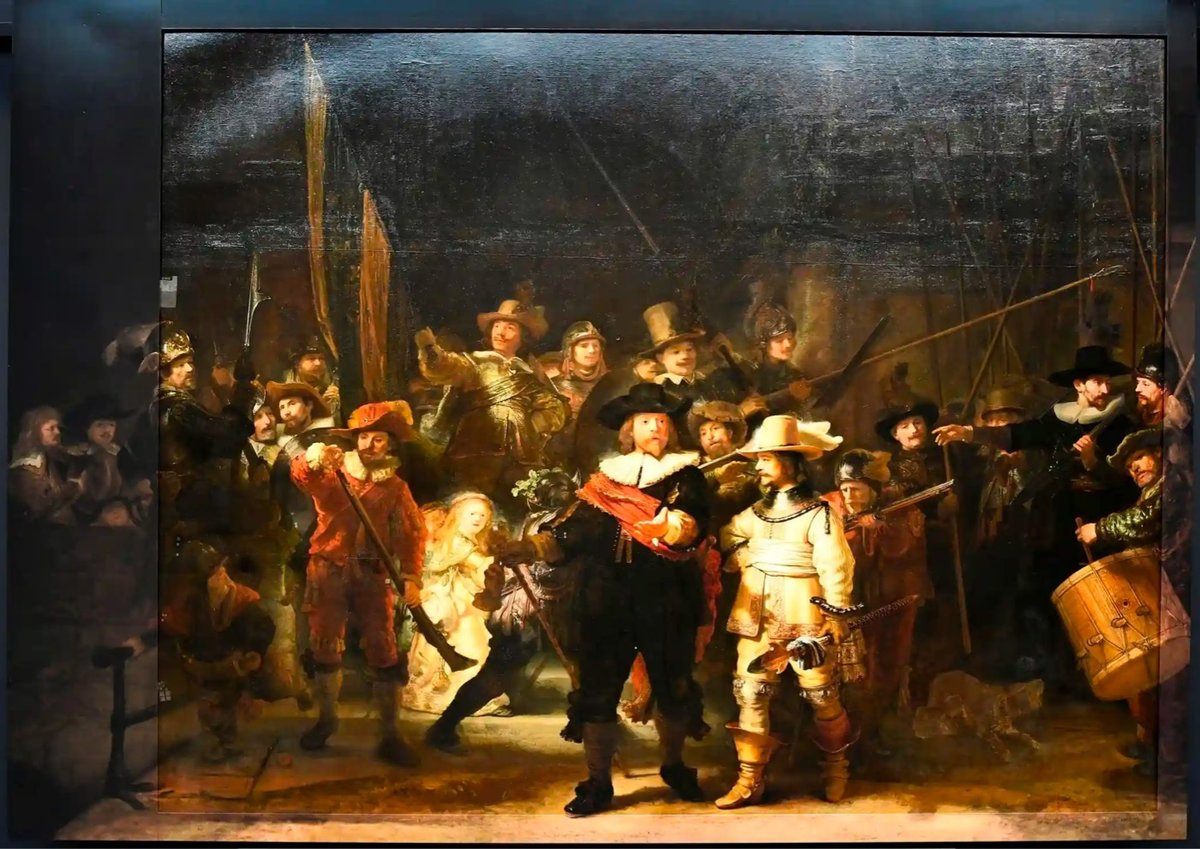
In 1715, a significant chunk of Rembrandt’s masterpiece The Night Watch, including a 2-foot-wide swath from the left side of the painting, was lopped off in order to fit the painting in a smaller space. (WTF?!) Using a contemporary copy of the full scene painted by Gerrit Lundens and an AI program for getting the colors and angles right, the Rijksmuseum has “restored” The Night Watch, augmenting the painting with digital printouts of the missing bits. The uncropped Rembrandt is shown above and here is Lundens’s version:
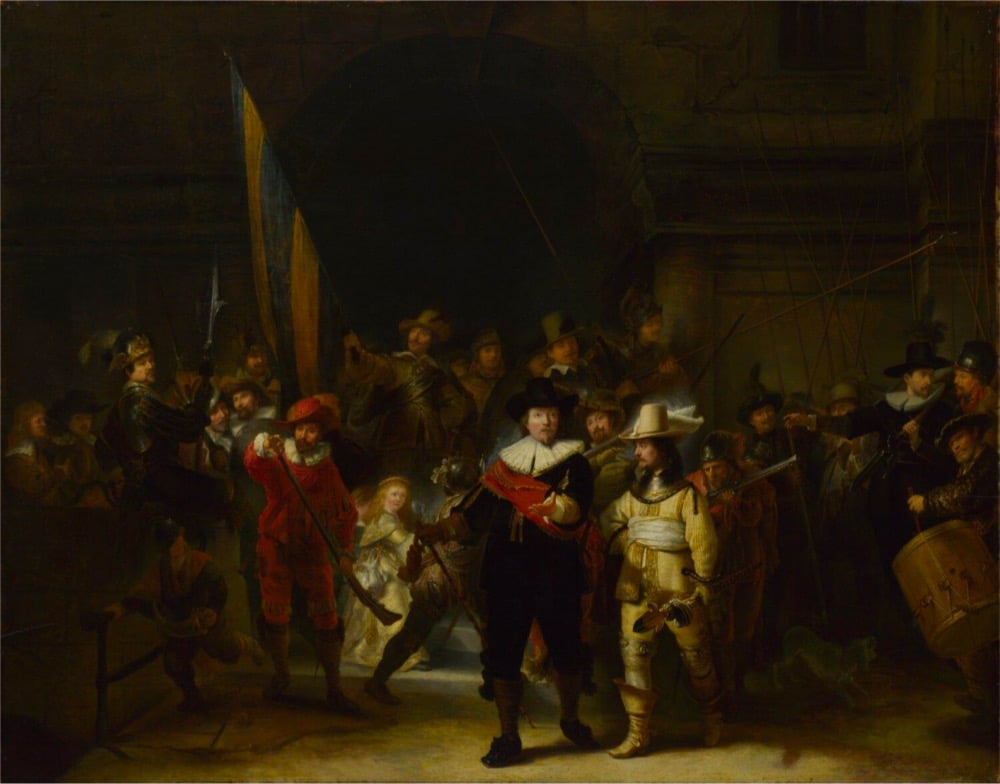
I’m not an expert on art, but the 1715 crop and the shift of the principal characters from right-of-center to the center appears to have radically altered the whole feel of the painting.
With the addition especially on the left and the bottom, an empty space is created in the painting where they march towards. When the painting was cut [the lieutenants] were in the centre, but Rembrandt intended them to be off-centre marching towards that empty space, and that is the genius that Rembrandt understands: you create movement, a dynamic of the troops marching towards the left of the painting.
(via @john_overholt)
Wow, this story! “On the morning after Juliane Diller fell to earth, she awoke in the deep jungle of the Peruvian rainforest dazed with incomprehension.”
See 1540 Paintings by Claude Monet in Two Hours
In just over two hours, this video presents 1540 paintings by impressionist master Claude Monet, a significant portion of his lifetime output. This is a really intriguing way to look at art. It’s not in-person and you don’t get a lot of time with each piece, but the video is HD, you can pause or slow the playback speed, and by seeing a lot of work over a short span of time, you can get a real sense of the stylistic choices and variations across Monet’s oeuvre — a view of the forest rather than the trees. (via open culture)
Bold & Colorful Minimalistic Portraits



Check out these striking portraits by Brazilian artist Luciano Cian from his Magna and Kuhle projects. Find more on his website, Behance, and Instagram. (via colossal)
New USPS Stamps Celebrate the Sun

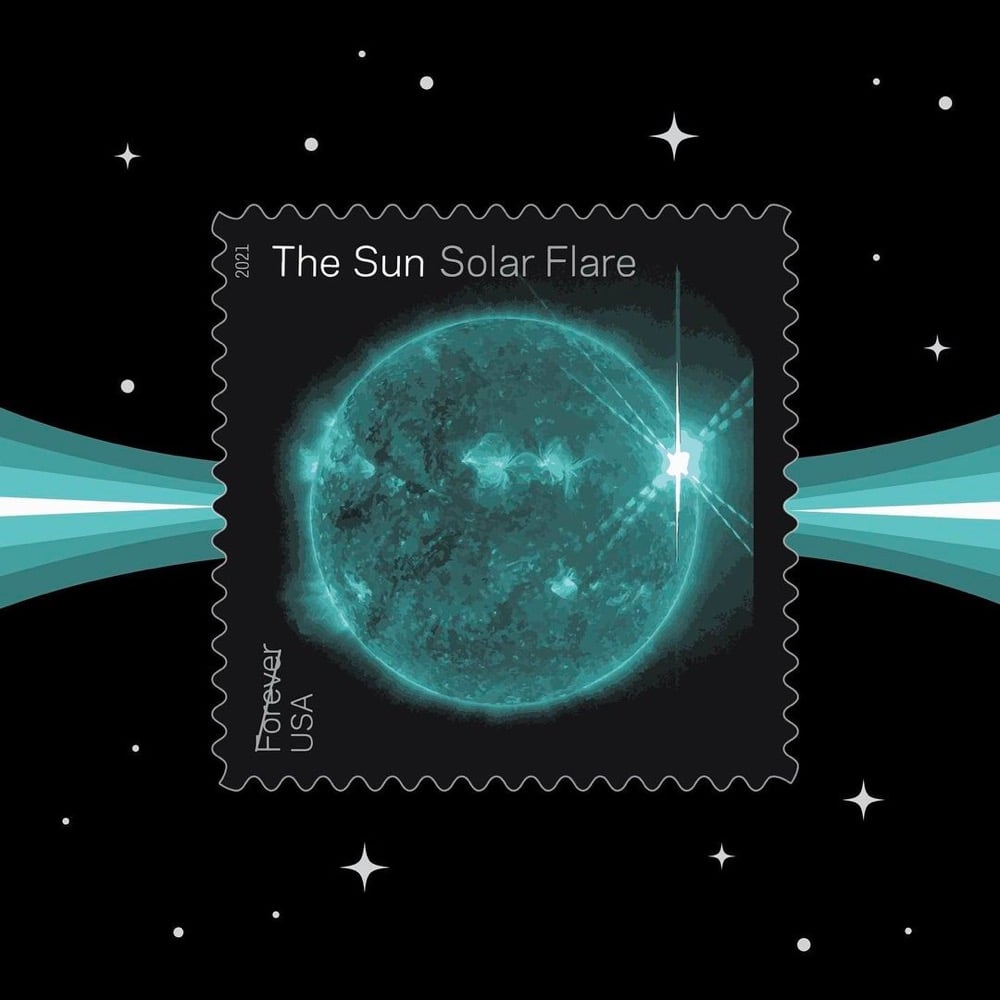

The US Postal Service has released a set of Sun Science stamps that use images from NASA’s Solar Dynamics Observatory to illustrate different solar phenomena like plasma blasts, sunspots, and solar flares.
Printed with a foil treatment that adds a glimmer to the stamps, the images on these stamps come from NASA’s Solar Dynamics Observatory, a spacecraft launched in February 2010 to keep a constant watch on the sun from geosynchronous orbit above Earth. The striking colors in these images do not represent the actual colors of the sun as perceived by human eyesight. Instead, each image is colorized by NASA according to different wavelengths that reveal or highlight specific features of the sun’s activity.
One of the stamps highlights sunspots, two feature images of coronal holes, two show coronal loops, two depict plasma blasts, one is a view of an active sun that emphasizes its magnetic fields, and two show different views of a solar flare.
NASA has more on the science behind the images on the stamps and the whole set of stamps are available for purchase online.
See also A Decade of the Sun.
“In the last four years, Costa Rica has generated 98.53% of its electricity from renewable sources.”
Dark Fish
Sometimes you run across an aspect of reality and it just completely blows your mind. You’ve heard of dark matter, right? Well, meet dark fish: biologists suspect that up to 95% of the world’s total fish population lives in a deep layer of the ocean that is difficult to detect and we know little about.
An international team of marine biologists has found mesopelagic fish in the earth’s oceans constitute 10 to 30 times more biomass than previously thought.
UWA Professor Carlos Duarte says mesopelagic fish — fish that live between 100 and 1000m below the surface — must therefore constitute 95 per cent of the world’s fish biomass.
“Because the stock is much larger it means this layer must play a more significant role in the functioning of the ocean and affecting the flow of carbon and oxygen in the ocean,” he says.
See also this thread from ocean scientist Andrew Thaler:
There’s a globe-spanning layer of mesopelagic fish that is so dense it distorts SONAR. For decades we had no idea what created the Deep Scattering Layer or why it moved. We still know almost nothing about it.
It’s astounding how much we don’t know about the ocean:
There’s an entire family of whales with at least 22 species that we know almost nothing about.
We know way more about stars that are billions of light years away than about some parts of the ocean a few hundred feet below the surface of our own planet.
See also dark fungi: “By one estimate, there are between 2.2 million and 3.8 million species of fungi — and more than 90% of them aren’t cataloged.”. (via @_zeets & @chadmumm)
The Inner Universe of Tropical Fruit
This stop motion animation takes us on a journey through various tropical fruits, as if we’re seeing animated MRI slices of them. If you’re wondering how it’s done, a behind-the-scenes immediately follows the animation. The sound design on this video is fantastic.
See also Hidden Patterns Inside Fruit (by the same creator) and WoodSwimmmer, a Gorgeous Stop Motion Journey Through Wood. (via moss & fog)
Mets pitcher Jacob deGrom is having an off-the-charts year. “Earth is 93M miles from the sun, and Jacob deGrom’s ERA in late June is 0.50: These are facts, we know them to be true, yet there is a very real difficulty in how to conceptualize them.”
The Freedom to Be: Black Surfers in the Rockaways
This short documentary takes a look at the Black surfing community in the Rockaways. These surfers are members of the Black Surfing Association (East Coast branch), which Surfer magazine profiled last summer:
“When you talk to kids here at Rockaway, they think of a surfer as John John Florence — blonde,” says Harris. “When I say, ‘Hey, I’m a surfer,’ they’re shocked. We’re trying to reach every kid, but we’re really trying to reach the kids that wouldn’t otherwise get the opportunity.
We just want to keep kids busy and active, and spread the message and spread the stoke of surfing, and go into schools and talk to kids about water safety.”
“There’s no racism out there”, says Harris of the ocean. “When you come out of that water, of course you go back to your life. But you lose yourself when you get into the waves.”
Black people are more likely to die in traffic accidents. Covid made it worse. “Drivers are less likely to slow down or stop for Black pedestrians than they are for white ones.”
Summer of Soul
Stevie Wonder. Mahalia Jackson. Nina Simone. Gladys Knight & the Pips. B.B. King. Sly and the Family Stone. Over six weeks in the summer of 1969, all of these legendary artists (and more!) performed at the Harlem Cultural Festival in NYC, drawing an estimated 300,000 people. The festival was filmed and broadcast on a local TV station, but the footage was never commercially released and so unlike that other 1969 festival, this event largely slipped from public memory.
Now, the Harlem Cultural Festival finally gets its due in the form of Summer of Soul, a forthcoming documentary directed by Questlove that uses that old footage to great effect. I’ve heard nothing but good things about this movie — it won both the Grand Jury Prize and the Audience Award at the Sundance Film Festival earlier this year. Summer of Soul is out in theaters and on Hulu July 2.
100 Visions of Fatherhood
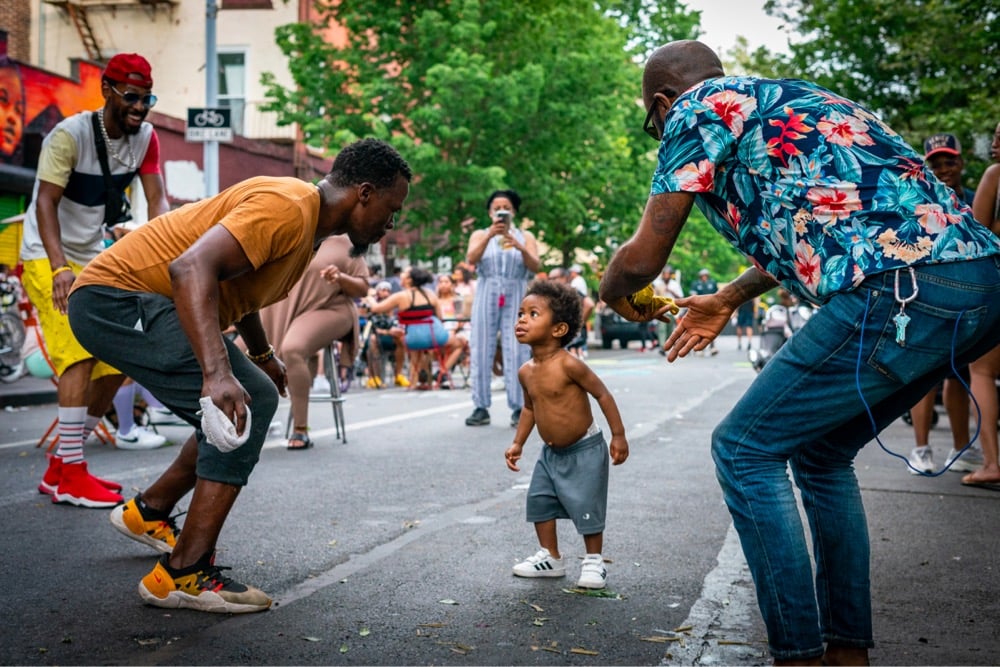


Just as they did last month in capturing motherhood, The Luupe has curated a collection of photos taken by women and non-binary photographers called 100 Visions of Fatherhood. Photos above by Amanda Addison, Kari Grimsby, and Hanifa Haris.
EVs Won’t Save Us from Our Car Culture’s Ill Effects
From Electric Vehicles Won’t Save Us by Coby Lefkowitz:
This isn’t a story about Elon Musk, or Tesla, or a contrarian take about how “oil is good, actually.” I unconditionally support electric vehicles in their quest to take over the primacy of gasoline-powered vehicles in the market. But I don’t save that enthusiasm for their prospects on society broadly. From the perspective of the built environment, there is nothing functionally different between an electric vehicle and a gasoline propelled one. The relationship is the same, and it’s unequivocally destructive. Cars, however they’re powered, are environmentally cataclysmic, break the tethers of community, and force an infrastructure of dependency that is as financially ruinous to our country as it is dangerous to us as people. In order to build a more sustainable future and a better world for humanity, we need to address the root problems that have brought us to where we so perilously lie today.
Believe
The second season of Ted Lasso starts on July 23rd and this new trailer has me all fired up. The first season was a very welcome diversion during the height of the pandemic and was an almost magical unicorn of a TV thing.
Is America finally rethinking its disastrous, racist, ineffectual, and deadly War on Drugs? “Drugs should be handled by doctors and therapists, not cops and prison guards.”
Charles Kellogg could put out fires using just the sound of his voice. Another cracking story from @tedgioia.
100 3D Artists Interpret the Same Scene of a Walking Person
Clinton Jones challenged his community of 3D artists to interpret a simple animation of a person walking with a heavy load. 2400 people participated and Jones collected the 100 renders for this video. What a fantastic illustration of the power of constraints and the abundance of human creativity. Ok, much of the imagery is borrowed from Star Wars and other sci-fi universes, but the stuff that isn’t is delightful. Even with no explicit narrative connection between the scenes, somehow this all seems like part of one big journey. One of the simplest stories we tell is someone moving from one place to another and it doesn’t need to be The Odyssey, Fury Road, or Thelma & Louise to be compelling.
You can also watch a video featuring all 2400 entries (it’s 2h 45m long) and a montage from a previous challenge featuring 125 artists.
See also Transfiguration: An Ever-Evolving Walking Figure. (via waxy)
I think this is the first political ad I’ve ever seen that features time travel? Great commercial for @JonesForAR, who’s running for governor of Arkansas.
Unexpected Minor Planet to Visit the Inner Solar System Soon
Well, this is cool: a recently discovered minor planet estimated to be between 62 and 230 miles across is currently journeying through our solar system and sometime in 2031 will be almost as close to the Sun as Saturn.
And it turns out, astronomers are about to witness the closest pass of this incredible round trip. Currently, 2014 UN271 is about 22 Astronomical Units (AU) from the Sun (for reference, Earth is 1 AU from the Sun). That means it’s already closer than Neptune, at 29.7 AU. And it’s not stopping there — it’s already traveled 7 AU in the last seven years, and at its closest in 2031, it’s expected to pass within 10.9 AU of the Sun, almost reaching the orbit of Saturn.
Before then, it’s expected to develop the characteristic coma and tail of a comet, as icy material on its surface vaporizes from the heat of the Sun. This close pass would give astronomers an unprecedented close look at Oort cloud objects.
C’mon NASA, let’s a get a probe fired up and visit this very unusual object!
What It’s Like to Be a Transgender Dad
In a TEDx Talk from 2017, LB Hannahs talks about their experience as a transgender dad, comfort vs authenticity, and the collision of theoretical gender roles & identities with the practicalities of parenthood.
Now, for most people, what their child will call them is not something that they give much thought to outside of culturally specific words or variations on a gendered theme like “mama,” “mommy,” or “daddy,” “papa.” But for me, the possibility is what this child, who will grow to be a teenager and then a real-life adult, will call me for the rest of our lives, was both extremely scary and exciting. And I spent nine months wrestling with the reality that being called “mama” or something like it didn’t feel like me at all. And no matter how many times or versions of “mom” I tried, it always felt forced and deeply uncomfortable. I knew being called “mom” or “mommy” would be easier to digest for most people. The idea of having two moms is not super novel, especially where we live.
So I tried other words. And when I played around with “daddy,” it felt better. Better, but not perfect. It felt like a pair of shoes that you really liked but you needed to wear and break in. And I knew the idea of being a female-born person being called “daddy” was going to be a harder road with a lot more uncomfortable moments. But, before I knew it, the time had come and Elliot came screaming into the world, like most babies do, and my new identity as a parent began. I decided on becoming a daddy, and our new family faced the world.
(thx, megan)
Guest Vocalist Dave Chappelle Sings Creep at Foo Fighters’ MSG Show
Well this is peak…something: last night surprise guest Dave Chappelle led fans in a singalong of Radiohead’s Creep at the Foo Fighters’ Madison Square Garden show (which you had to be vaccinated to get in to). Not much more to say about it — you’re either going to watch it or not based on that info. Nature is healing?!
A career waiter explains why restaurants are having trouble hiring staff. “Workers are staying away because the industry has never treated them with respect…”
A new study indicates the high death rate of Black Americans during the pandemic was due primarily to the poor quality of the hospitals they were admitted to. “Hospitals mattered more than […] age, income, or other medical conditions.”
The Best Commercial About a Rock Quarry You’ll See Today
This advertisement from Vermont granite company Rock of Ages, featuring views of their majestic quarry accompanied by soaring opera, is way better than any commercial for a local quarry has any right to be.
See also The Quarryman’s Symphony, an all-time favorite post of mine about the hand signals used by a quarry boss guiding his marble harvesting crews. (via @AndrewLiptak)
There will almost certainly be another wave of Covid-19 cases in the US because of the delta variant (B.1.617.2) – the UK is already seeing one. How bad it gets depends on how many more ppl are vaccinated.
The secret weapon of many top European football teams is their grounds-management team. The pitch affects how fast teams can play. “When Pep Guardiola arrived at Manchester City in 2016, he asked for the grass to be cut to just 19mm.”
Sourcing Design Objects Used in Star Trek
Production designers working on science fiction movies and TV shows are part-time magicians because they routinely have to invent the future using things from the present. The site Star Trek + Design is collecting the futuristic design objects — chairs, cups, silverware, sofas — that designers used on the sets of Star Trek movies and TV shows to depict the future.
Being drawn to the aesthetics of Trek, especially of The Next Generation, made me curious about the specific objects that set designers used to create the visual embodiment of what living and working on a starship would look like in a technologically-advanced, post-scarcity future.
For instance, this is an RBT Chair by Teknion used in Star Trek: Discovery:

Park Avenue glasses made by Anchor Hocking were used for barware in TNG:
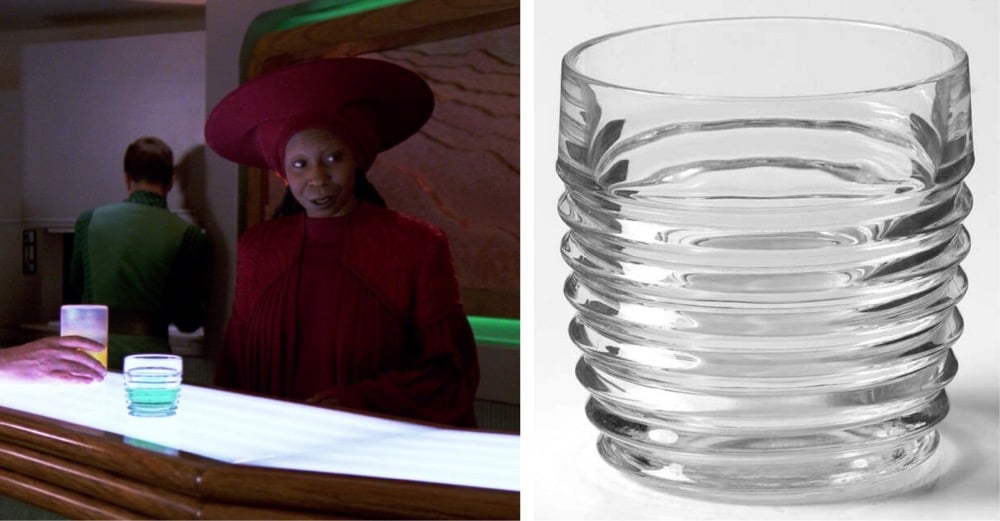
Voyager used Arne Jacobsen’s AJ Flatware in several episodes (as did Kubrick’s 2001):

Check out the site for many more sourced objects.
See also Film and Furniture, a Site About the Decor in Movies.
Supporting your country’s football team is complicated these days. “England is by many objective measures a terrible country ruled by terrible people with a terrible past and a terrifying future, and I support England.”
Great White Sharks Closely Observed from Above
Carlos Gauna has been recording great white sharks and other sea life with a drone off the coast of California, capturing behaviors that many of us rarely see. This video includes infrared footage, so we can observe what sharks get up to in the dark. (via digg)
Some Fun Typefaces for 2021
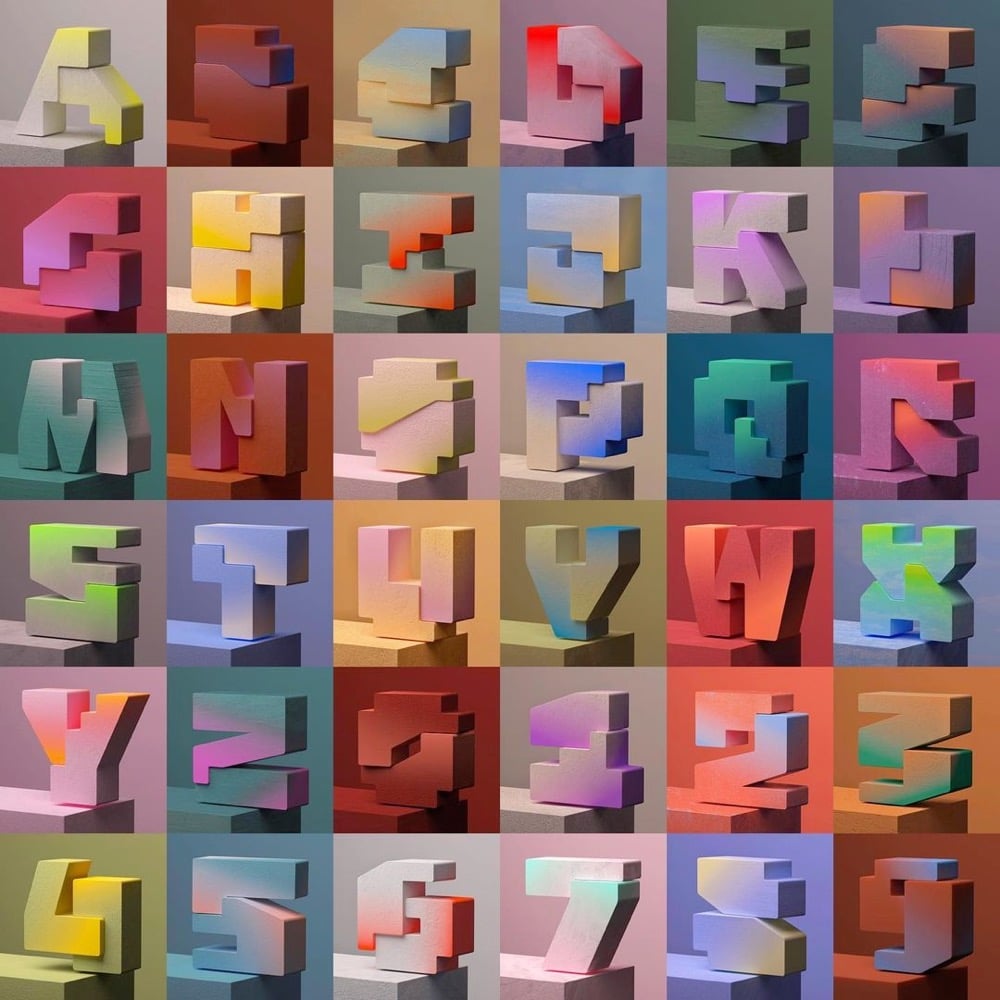
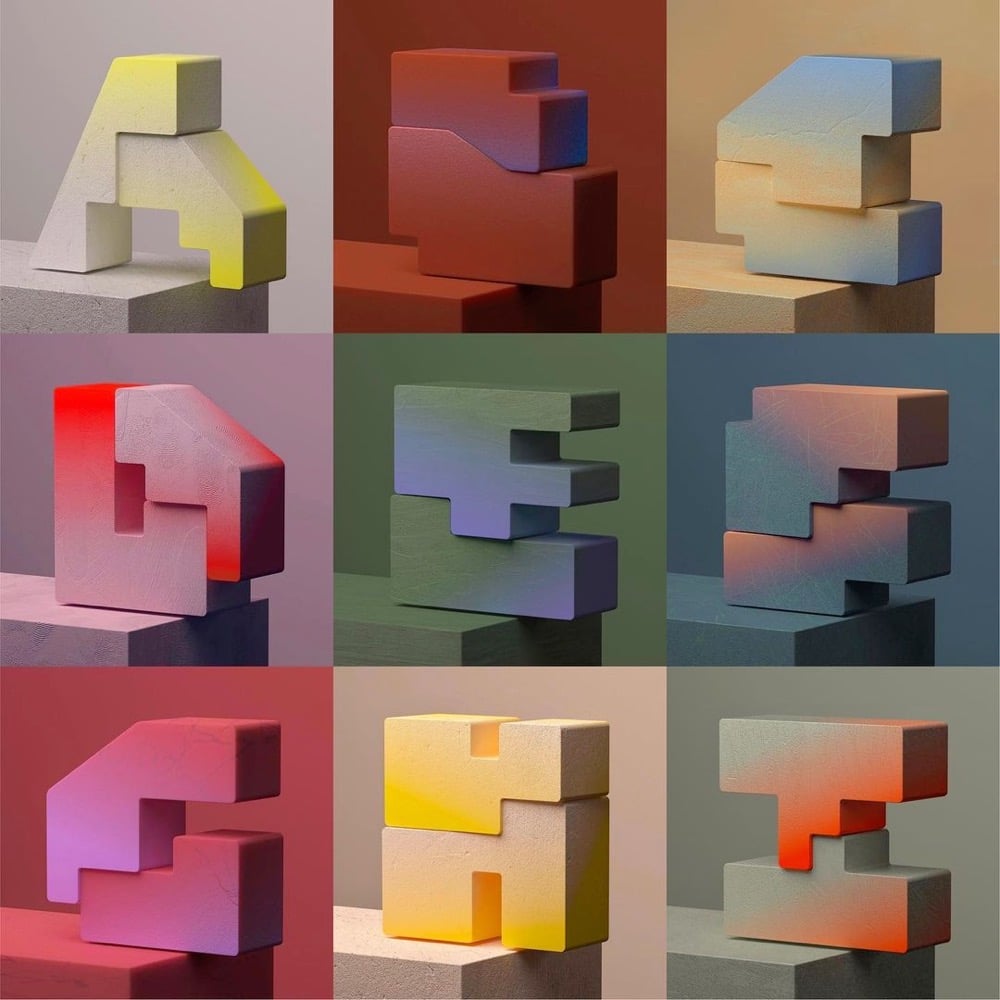
Adobe recently announced the winners of their 36 Days of Type contest and Khyati Trehan’s effort (pictured above) was among them. I also really liked David Oku’s colorful animated typeface. You can check out more work from this year’s project here and here (including this entry of handmade and found items).
There’s No Such Thing as a Tree
Obviously, there are trees. But speaking phylogenetically, trees aren’t a thing. Some things that are trees evolved from things that are not trees and other things that are trees evolved into things that aren’t trees. Confused? This might clear things up.
“Trees” are not a coherent phylogenetic category. On the evolutionary tree of plants, trees are regularly interspersed with things that are absolutely, 100% not trees. This means that, for instance, either:
The common ancestor of a maple and a mulberry tree was not a tree.
The common ancestor of a stinging nettle and a strawberry plant was a tree.
And this is true for most trees or non-trees that you can think of.
See also there’s no such thing as a vegetable and there’s no such thing as a fish.
What would the evolutionary tree of salmon, lungfish, and cows be? The answer, it appears at first glance, is simple. Salmon and lungfish, being fish, would cluster nicely together on one branch, and very non-fishy cows would be off on a separate branch. Right? Wrong. Contrary to what you might expect, what you see above is their evolutionary tree. Working up from the root, the lineage that leads to salmon branches off first. Keep tracing up the tree, and you’ll see that the lineage from which the salmon branched off eventually branches into two new lineages: the one leading to lungfish and the other leading to cows. In other words, a cow and a lungfish are more closely related to one another than either is to salmon.
(via @smorewithface)
Patrick Stewart Does Hamlet on Sesame Street
Patrick Stewart, displaying the Shakespearian acting chops that landed him the role of Captain Picard on Star Trek: The Next Generation, appeared on Sesame Street in 1996, performing a parody of Hamlet’s soliloquy with the letter “B”. Stewart never doesn’t give it his all when acting.
Gerrymander Jewelry, pendant necklaces in the shape of oddly shaped Congressional districts. They take custom orders but “some districts are too breakable” to sell because they’re so gerrymandered.
Just started listening to Nixon at War, a podcast about Richard Nixon & Vietnam hosted by @kbandersen. A sequel to the excellent LBJ’s War and LBJ and the Great Society podcasts.
Dragon’s Blood Trees

This is a dragon’s blood tree from the island of Socotra off the coast of Yemen in the Arabian Sea. You can see the mathematics of nature at work here — self-similarity at different scales, growing to fill the available space, efficient branching behavior…I bet there’s some cool Fibonacci shit going on here too. The photo was taken by Daniel Kordan — you can see more of this series at Colossal, on Instagram, or at Fstoppers. (via colossal)
California’s Last Fire Season Was a Historic Disaster. This One Might Be Worse.
Cycling myth: wide tires are slower than thin tires. “The increased vibrations of the narrower tires caused energy losses that canceled out the gains from the reduced flex.”
The Rashomon Effect
In Akira Kurosawa’s 1950 film Rashomon, the story of the murder of a samurai is told from several different viewpoints and each account of the event is different and even contradictory. In real life as in cinema, the Rashomon Effect describes how events can be recalled in contradictory ways by well-meaning but ultimately subjective witnesses. In this short TED-Ed video, the Rashomon Effect and its implications are explained and explored. (via open culture)
“Researchers have found that Earth’s energy imbalance approximately doubled during the 14-year period from 2005 to 2019.” The Earth is increasingly absorbing more of the Sun’s energy than it is emitting thermal radiation.
Three Transgender Kids Share Their Stories
Over at A Cup of Jo, Joanna Goddard interviewed three kids who are transgender about their experiences. Here’s Violet, she/her, age 13:
What do you wish people knew about being trans?
The main thing is that it’s not a choice. It’s a choice to come out, but being trans is not a choice. It wasn’t like one day I woke up and felt the way the wind blew and wanted to be a girl. I ALWAYS knew I wasn’t a boy. It wasn’t that I wanted to be a girl; I WAS a girl. I just had to put that into words and explain that.
Aya, she/her, age 9:
How did you tell your parents?
There was one night when my sister was like, ‘So… Mommy’s a girl, I’m a girl, Daddy’s a boy, and you’re a boy.’ But I immediately was like, ‘No, no, I’m a girl.’ And that was the first time, but there was another time. We were driving back from Mommy’s school, and she was telling me about the different words like transgender and all different words and when she described transgender, I was like, that’s me. I was five.
And this:
Also, fun fact: When we were watching a Mo Willems episode about drawing, he told us that his child is transgender — the one from Knuffle Bunny. Trixie is now Trix!
The comments on the post are worth reading as well — CoJ has the best comments section on the internet, quite a feat for 2021.
A Minute by Minute Account of the Day the Dinosaurs Died
Perhaps the most consequential day in the Earth’s recent history was when a massive asteroid struck the planet 66 million years ago. It resulted in earthquakes, tsunamis, fireballs raining from the sky, volcanoes, atmospheric heat shocks, wildfires, global winter, and the extinction of 75% of all species on Earth, including the dinosaurs. This video by Kurzgesagt leads us through what happened that day, minute by minute.
This video reminded me of Peter Brannen’s eye-popping description of this event from his book The Ends of the World:
“The meteorite itself was so massive that it didn’t notice any atmosphere whatsoever,” said Rebolledo. “It was traveling 20 to 40 kilometers per second, 10 kilometers — probably 14 kilometers — wide, pushing the atmosphere and building such incredible pressure that the ocean in front of it just went away.”
These numbers are precise without usefully conveying the scale of the calamity. What they mean is that a rock larger than Mount Everest hit planet Earth traveling twenty times faster than a bullet. This is so fast that it would have traversed the distance from the cruising altitude of a 747 to the ground in 0.3 seconds. The asteroid itself was so large that, even at the moment of impact, the top of it might have still towered more than a mile above the cruising altitude of a 747. In its nearly instantaneous descent, it compressed the air below it so violently that it briefly became several times hotter than the surface of the sun.
“The pressure of the atmosphere in front of the asteroid started excavating the crater before it even got there,” Rebolledo said. “Then when the meteorite touched ground zero, it was totally intact. It was so massive that the atmosphere didn’t even make a scratch on it.”
Unlike the typical Hollywood CGI depictions of asteroid impacts, where an extraterrestrial charcoal briquette gently smolders across the sky, in the Yucatan it would have been a pleasant day one second and the world was already over by the next. As the asteroid collided with the earth, in the sky above it where there should have been air, the rock had punched a hole of outer space vacuum in the atmosphere. As the heavens rushed in to close this hole, enormous volumes of earth were expelled into orbit and beyond — all within a second or two of impact.
“So there’s probably little bits of dinosaur bone up on the moon,” I asked.
“Yeah, probably.”
A big story from the NY Times on how Amazon thrived during the pandemic, often with little regard for their employees. “Amid the pandemic, Amazon’s system burned through workers…”
Surprising Shared Word Origins
Using publicly available datasets of English words, their etymologies, and their semantic distances, software engineer Daniel de Haas generated pairs & triples of words that have a common origin but otherwise are unrelated to each other.
“actor” & “coagulate”
Both of these words derive ultimately from the Latin “ago”, meaning “act”, “do”, “make”, and a bunch of other things.English “actor” is a short hop away from “ago”, but “coagulate” takes a longer path: “ago” ➔ “cogo” (“collect”) ➔ “coagulum” (“a clot”) ➔ “coagulo” (“to clot”).
“educate” & “subdue”
I never would have picked those two words out of a lineup as having a shared etymological root, but sure enough it sits right there — the “du” in the middle of each word, which ultimately derives from Latin “duco”, meaning “lead”.“Educate” comes from the Latin “eductus”, meaning to “lead or bring out”, and then the Latin “educare” (“raise, train, mould”). I love the image of education as the process of extruding a refined person out of a base of unrefined material.
“Subdue” comes from the latin “subduco”, meaning “lead under”. Again, a very clear physical description of what the word means — to put beneath you, or bring under control.
Update: Oh here’s a good one: the words “fascism” and “fajita” are both derived from the same Latin root.
Embroidered Forests

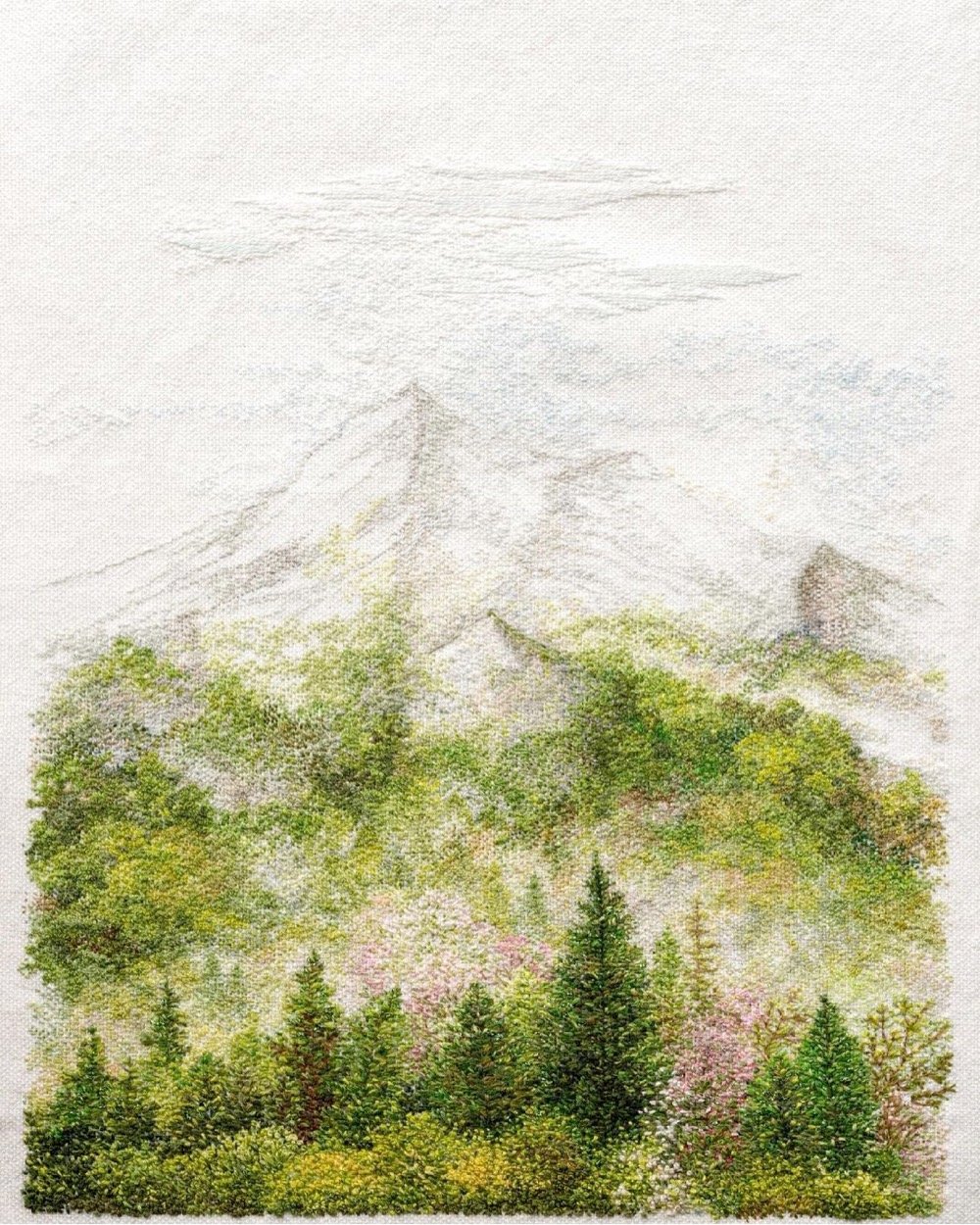
I am enjoying these embroidered forest landscapes by Katrin Vates. The stitching provides a lovely & subtle variable depth to the bushy trees that you don’t get from a drawing or painting.
The Information Visualization Revolution

For the New Yorker, Hannah Fry wrote a brief history of information visualization, a quiet innovation that has changed the world:
Van Langren could have put these values in a table, as would have been typical for the time, but, as Friendly and Wainer observe, “only a graph speaks directly to the eyes.” Once the numbers were visualized, the enormous differences among them — and the stakes dependent on those differences — became impossible to ignore. Van Langren wrote, “If the Longitude between Toledo and Rome is not known with certainty, consider, Your Highness, what it will be for the Western and Oriental Indies, that in comparison the former distance is almost nothing.”
Van Langren’s image marked an extraordinary conceptual leap. He was a skilled cartographer from a long line of cartographers, so he would have been familiar with depicting distances on a page. But, as Tufte puts it, in his classic study “Visual Explanations” (1997), “Maps resemble miniature pictorial representations of the physical world.” Here was something entirely new: encoding the estimate of a distance by its position along a line. Scientists were well versed in handling a range of values for a single property, but until then science had only ever been concerned with how to get rid of error — how to take a collection of wrong answers and reduce its dimension to give a single, best answer. Van Langren was the first person to realize that a story lay in that dimension, one that could be physically seen on a page by abstracting it along a thin inked line.
Van Langren’s graph, which Fry says “might be the first statistical graph in history”, is pictured at the top of this post.
It’s Great to Hang Out After Self-Isolating for a Year - I’m Not Acting Weird, Am I? “Say, can we talk about how when we walked in here a minute ago, I straight up screamed? I was just stunned to be inside of a business.”
Bone Music: Forbidden Soviet Records Made From Used X-Ray Films
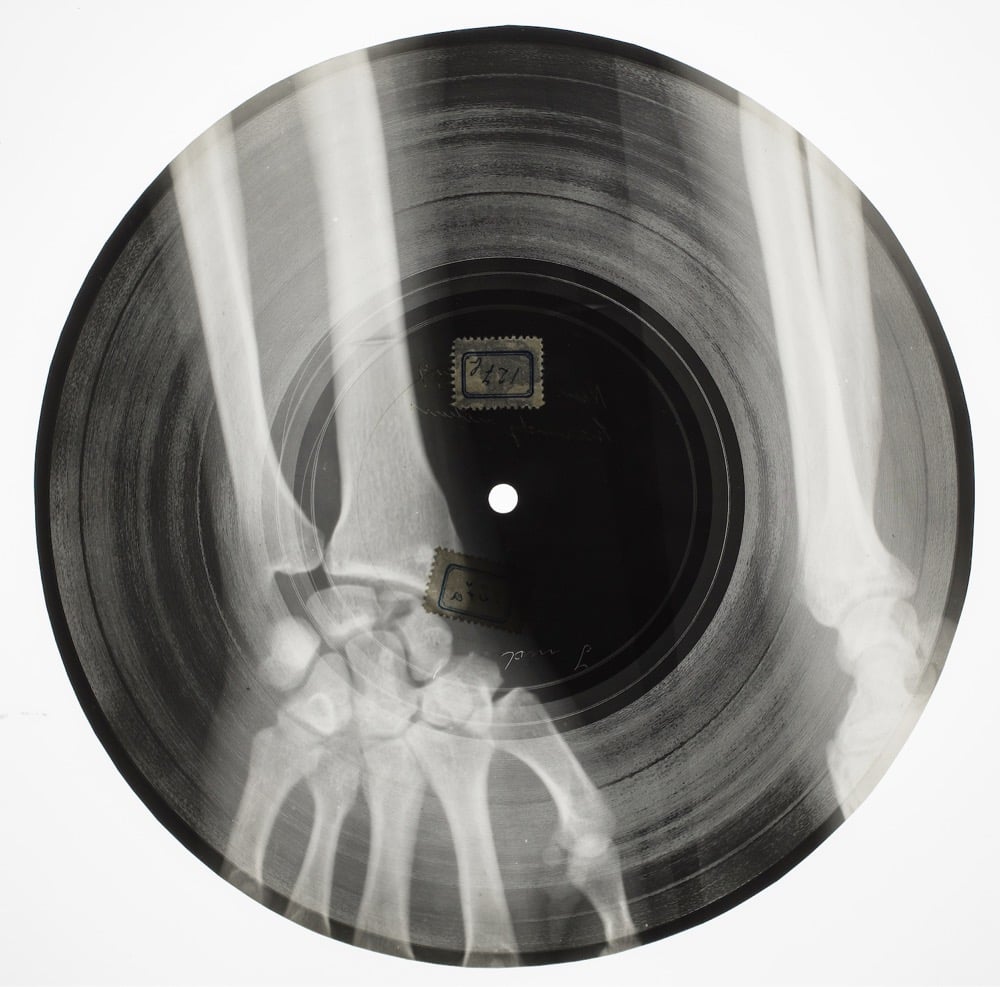
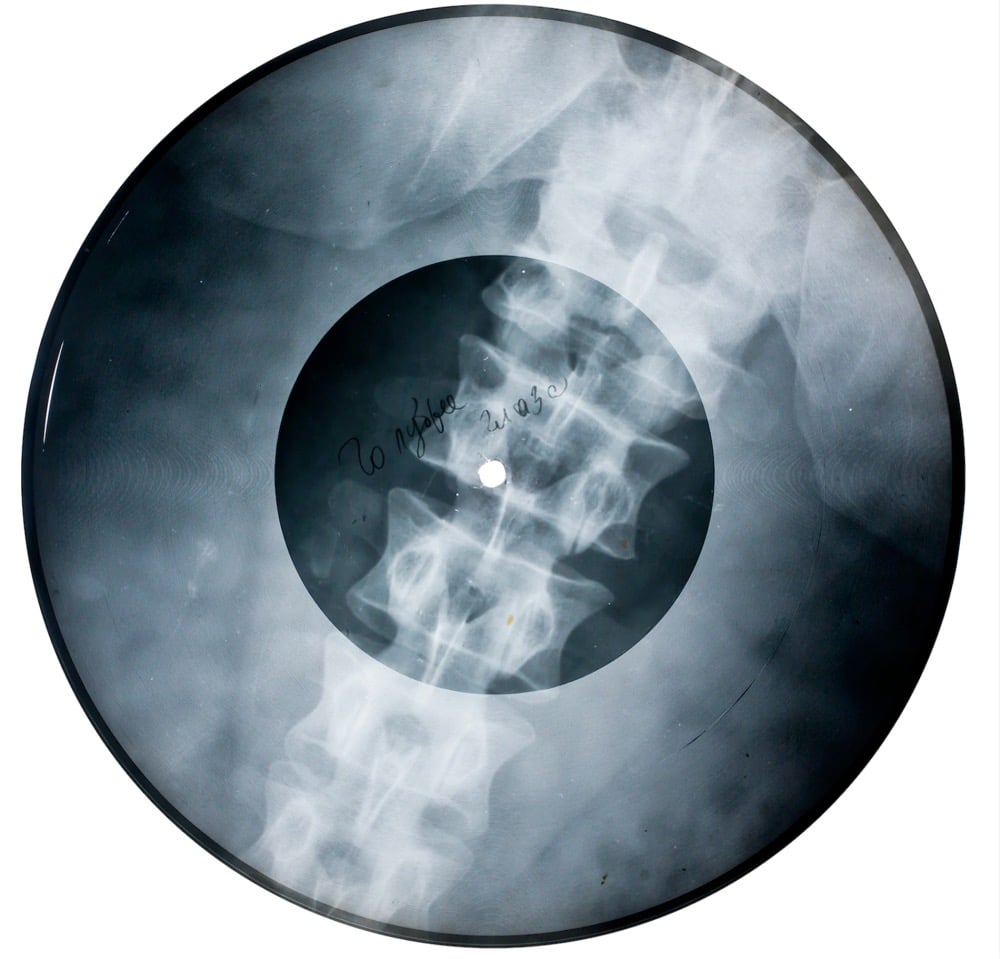
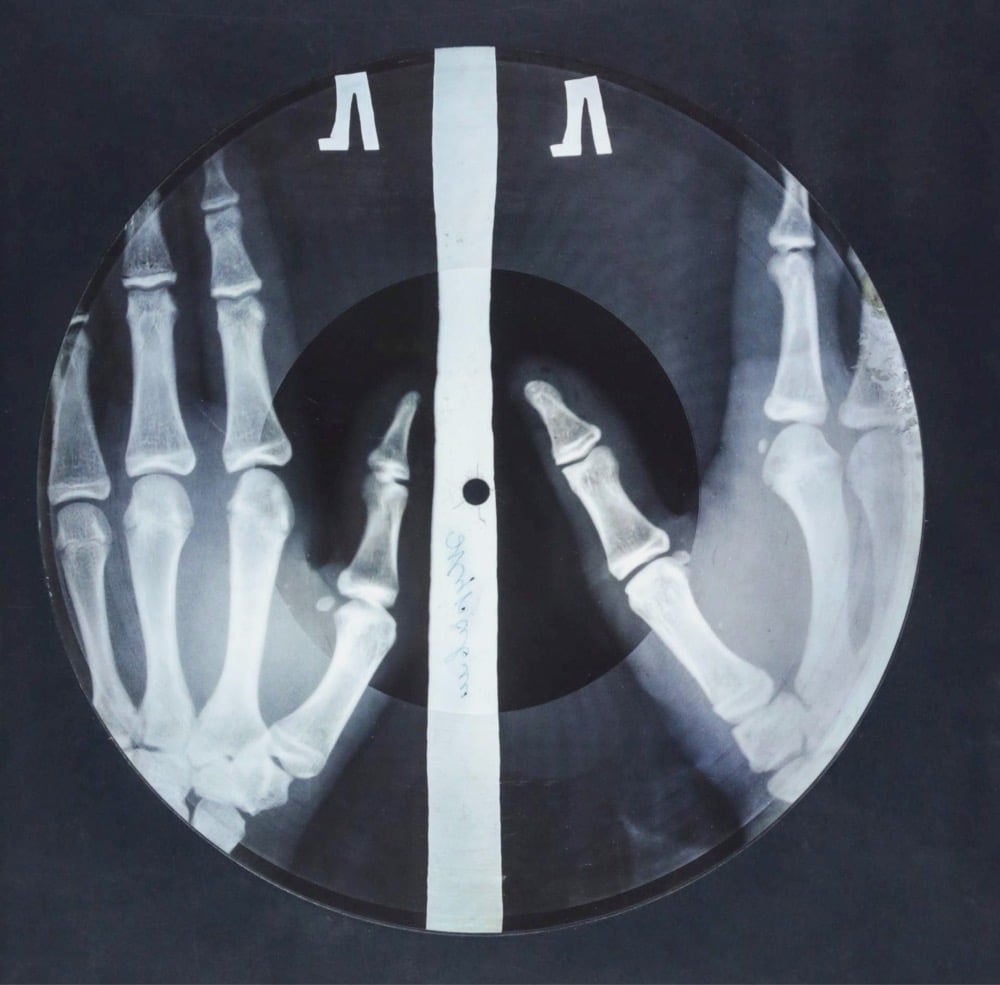
During the Cold War, the Soviet Union controlled the music recording industry and even restricted the types of music that were allowed to be played & listened to. Or they tried to anyway. Enterprising Soviet bootleggers took used x-ray films, many of them still containing images of bones and skulls, and recorded forbidden music on them, including jazz and rock & roll from the West. They called it ribs, bones, bone music, or jazz on ribs. From a 2017 article in Vice:
X-rays proved to be an suitable medium. They were cheaply and easily (albeit illegally) acquired from local hospitals that were required to throw out the flammable sheets. They took the groove relatively well, though nowhere near as well as vinyl — some X-ray discs apparently sound like listening to music through sand — and they were easy to fold into a shirt sleeve of pocket for a quick transaction. The X-rays were also stunningly beautiful.
And from an NPR article on Soviet samizdat:
Before the availability of the tape recorder and during the 1950s, when vinyl was scarce, ingenious Russians began recording banned bootlegged jazz, boogie woogie and rock ‘n’ roll on exposed X-ray film salvaged from hospital waste bins and archives.
“Usually it was the Western music they wanted to copy,” says Sergei Khrushchev. “Before the tape recorders they used the X-ray film of bones and recorded music on the bones, bone music.”
“They would cut the X-ray into a crude circle with manicure scissors and use a cigarette to burn a hole,” says author Anya von Bremzen. “You’d have Elvis on the lungs, Duke Ellington on Aunt Masha’s brain scan - forbidden Western music captured on the interiors of Soviet citizens.”
To learn more about bone music, you can check out Stephen Coates’ book X-Ray Audio, The X-Ray Audio Project (which includes digital recordings made from some of the bone records — here’s Lullaby of Birdland by Ella Fitzgerald), and this short documentary:
pOrtal, a Seamless Sci-fi Video Link Between Cities

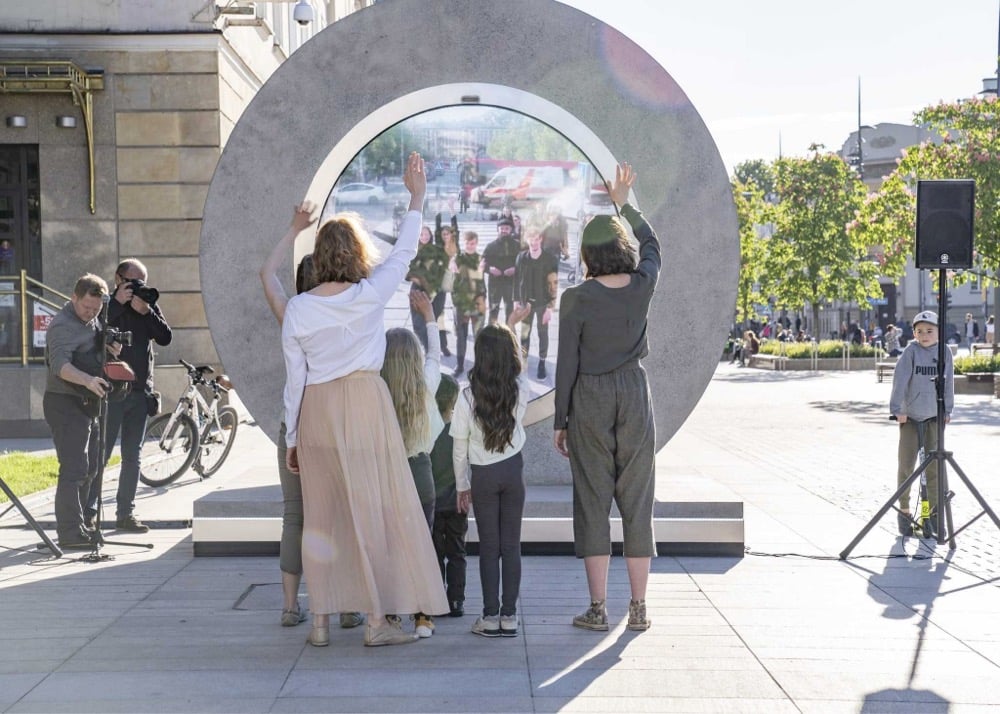
pOrtal is a project that allows for people in two different locations to interact via circular video screens. Right now, the link is between Vilnius, Lithuania and Lublin, Poland but there are plans to add more cities (Reykjavik/Vilnius and Vilnius/London to start). The production is a bit over-the-top (e.g. the video), but the idea of fun, seamless, sci-fi presence between two locations is a good one. (via moss & fog)
The 25 greatest achievements in dumb internet video, e.g. Strong Bad, Downfall parodies, keyboard cat, etc.
In a recent trial, the use of virus-blocking bacteria in mosquito populations reduced the incidence of dengue fever by 77%. Between stuff like this, mRNA vaccines, and CRISPR, we’re set to make major progress against deadly disease in the next 10 years.
Ed Yong of The Atlantic won a well-deserved Pulitzer Prize for his outstanding coverage of the pandemic. Cheers, @edyong209!
Soothing Shutter Sounds of 18 Cameras
Photographer Sails Chong recorded something we don’t hear much of these days: the sounds of camera shutters. Accompanied by a song by Arcade Fire from the Her soundtrack, Chong presents the shutter sounds of 18 different cameras, from 35mm all the way up to large format cameras. Interestingly, the lineup does not include the iconic Leica shutter sound — “a photograph sounds like a kiss”. (thx, david)
I love a good errand hang. “The errand hang dances in the sweet vulnerability that comes from the everyday.”
The Shortcut. Once begun, it’s difficult not to watch this all the way through.
Yo-Yo Ma Answers Questions About the Cello
As part of the Tech Support series, Wired had Yo-Yo Ma answer some questions about the cello and music sent in by Twitter users. What I like about this is that no critic or professional interviewer would ask these questions (they are “bad” interview questions) and yet Ma answers them all generously and thoughtfully. It reminds me a little bit of when Vogue trained an AI program to interview Billie Eilish:
What I really loved hearing Billie say was that human interviewers often ask the same questions over and over, and she appreciated that the AI questions don’t have an agenda in the same way, they’re not trying to get anything from her.
Perhaps with interesting subjects who are game, having “good” interview questions maybe isn’t that important, particularly if they are repeated queried about the same topics in every interview.
Give Yourself Permission to be Creative
At TED2020, Ethan Hawke gave a remote talk about the benefits of being creative. As someone who often struggles to find meaning in whatever it is I do here, this bit was especially good to hear:
Do you think human creativity matters? Well, hmm. Most people don’t spend a lot of time thinking about poetry. Right? They have a life to live, and they’re not really that concerned with Allen Ginsberg’s poems or anybody’s poems, until their father dies, they go to a funeral, you lose a child, somebody breaks your heart, they don’t love you anymore, and all of a sudden, you’re desperate for making sense out of this life, and, “Has anybody ever felt this bad before? How did they come out of this cloud?”
Or the inverse — something great. You meet somebody and your heart explodes. You love them so much, you can’t even see straight. You know, you’re dizzy. “Did anybody feel like this before? What is happening to me?” And that’s when art’s not a luxury, it’s actually sustenance. We need it.
(via swissmiss)
For the First Time Since Early 2020…
For many of us in the US and other parts of the world, with Covid-19 on the decline because of vaccinations, the last month or two has seen people getting back into the world for the first time since the pandemic began in early 2020. XKCD’s Randall Munroe plotted out some of these experiences on a scale from “normal” to “alarming”:
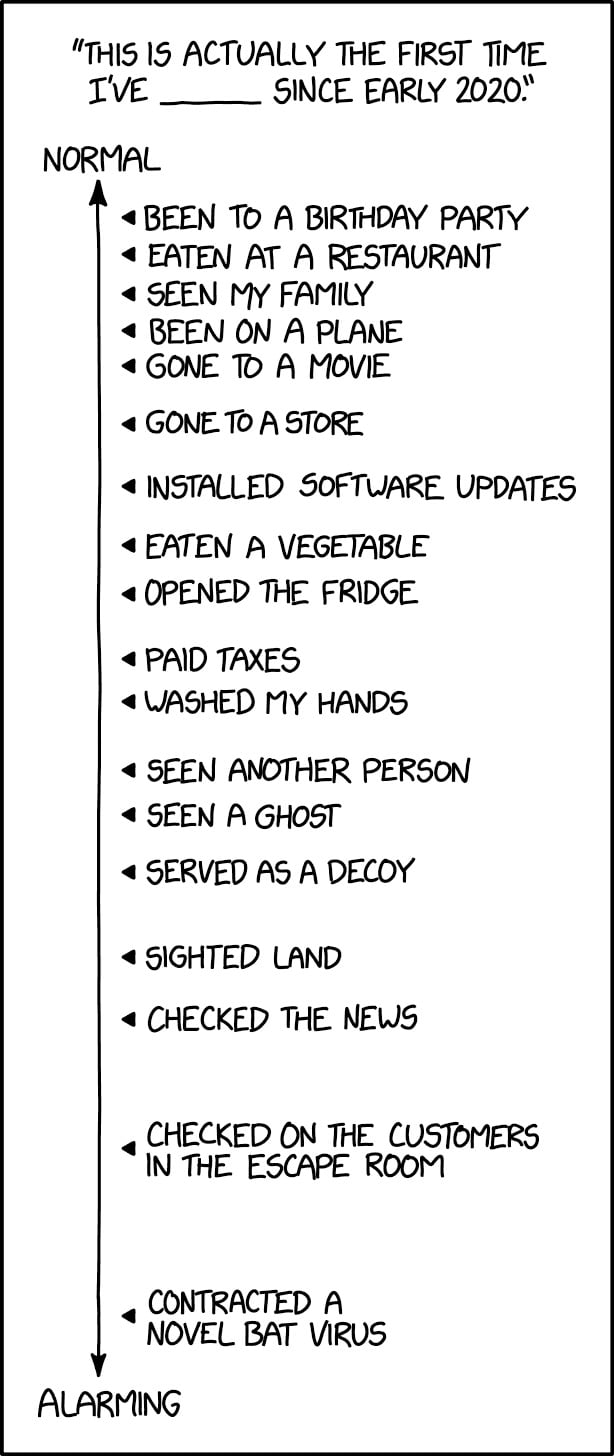
Transformation of a Bonsai Tree Over 12 Months
Ever since I learned about bonsai trees as a kid, I’ve been fascinated with them. In my 20s, my girlfriend bought me a juniper bonsai for my birthday. I was really excited to see what I could do with it, but it was dead in a month and a half, forever dimming my enthusiasm for ever practicing bonsai myself. But I still love observing the process and seeing the results, so I’ve enjoyed watching Bucky Barnes’1 Bonsai Releaf videos. His latest video (above) documents the year-long transformation of a Japanese larch tree he purchased for £30 into something that looks like it’s been majestically clinging to a windswept cliff for hundreds of years.
Observation, healing, experimentation, growth, making irreversible choices — so many lovely little themes, lessons, and moments in this video. At one point, well into the process, he clips off most of a long branch and I exclaimed “Oh my God!” out loud. I guess I still need to work on letting go of attachments.
A portable planetarium owner shares about how they talk to people who believe the Earth is flat. “These people fold pretty quickly if you can answer 3 questions in a row. They are looking for something to believe, they want to feel smart.”
Nikola Jokic, Unlikely NBA MVP
To the casual basketball fan, Nikola Jokic seems like an unlikely pick for NBA MVP. Outwardly, his game resembles middle-aged-guy-at-the-rec-center — “god-tier old man game” is how Gene Demby put it — but this video makes a good case that Jokic is “revolutionizing the center position”, “the best offensive passing big man ever”, and possibly even “the best offensive center in NBA history”.
The Keystone XL Pipeline Is Officially Dead. “We were not willing to sacrifice our water or safety for the financial benefit of a trans-national corporation.”
The 30 Greatest Action Movies of All Time. Great to see personal favorite Drunken Master II on here.
The Circles of Friendship
This chart caught my eye yesterday:
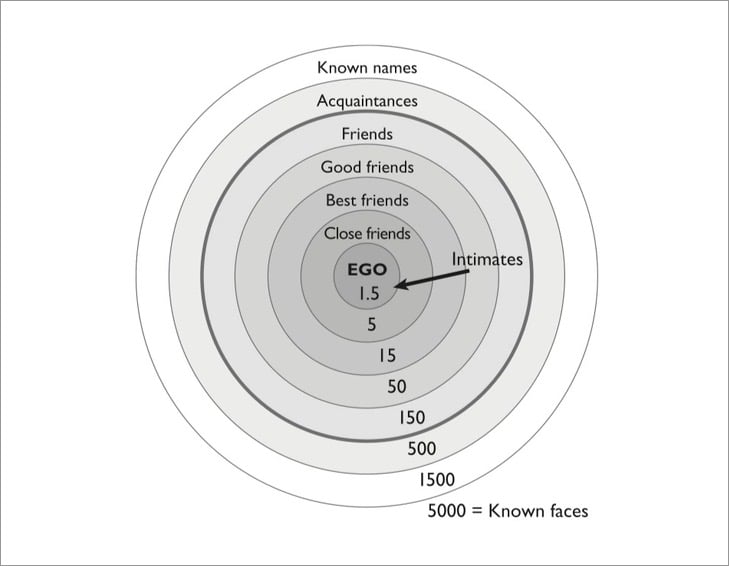
It’s from Robin Dunbar’s recent book, Friends: Understanding the Power of Our Most Important Relationships. You might recall the author’s name from his concept of Dunbar’s number:1 that on average people can maintain about 150 friendships with others, a limit that is determined by human brain size and function. The chart is a more detailed version of the concept: it shows, roughly, the number of people we can have meaningful relationships with at various levels of intimacy. Dunbar explains in this Atlantic interview:
The innermost layer of 1.5 is [the most intimate]; clearly that has to do with your romantic relationships. The next layer of five is your shoulders-to-cry-on friendships. They are the ones who will drop everything to support us when our world falls apart. The 15 layer includes the previous five, and your core social partners. They are our main social companions, so they provide the context for having fun times. They also provide the main circle for exchange of child care. We trust them enough to leave our children with them. The next layer up, at 50, is your big-weekend-barbecue people. And the 150 layer is your weddings and funerals group who would come to your once-in-a-lifetime event.
The layers come about primarily because the time we have for social interaction is not infinite. You have to decide how to invest that time, bearing in mind that the strength of relationships is directly correlated with how much time and effort we give them.
The interview is interesting throughout — there’s evidence that introverts have fewer connections in each layer than extroverts, your numbers go down as you get older when relationship become harder to replace, “falling in love will cost you two friendships”, and how much time is necessary to form a friendship:
It takes about 200 hours of investment in the space of a few months to move a stranger into being a good friend. This fits with our data, which suggests that close friends are very expensive in terms of time investment to maintain. I think the figures are a guideline rather than precise. It just means friendships require work.
I’ve been thinking a lot about friendship over the many months of the pandemic — about how my friend circles changed during that time and what friendship actually means to me. It is not much of an exaggeration to say that my close friends saved my life during the past year — there were 3 or 4 people that I leaned heavily on (and they on me) for advice, sanity checks, shoulder-crying, going on long walks, emotional support, grieving, getting unfunked, relationship advice, and generally feeling like a normal & whole person in the midst of an unprecedentedly awful situation. We talked and cried and raged about anything and everything. We went deep and got intimate. If there’s a silver lining to the pandemic for me, it’s the development and deepening of these incredible friendships. ♥
Fun note on this… When I searched to find the Wikipedia page for Dunbar’s number, Google helpfully(?) gave me the phone number for a local physical therapist named Dunbar.↩
America’s Individualism and Our Poor Pandemic Response
Ed Yong writing in The Atlantic, Individualism Is Still Sabotaging the Pandemic Response:
From its founding, the United States has cultivated a national mythos around the capacity of individuals to pull themselves up by their bootstraps, ostensibly by their own merits. This particular strain of individualism, which valorizes independence and prizes personal freedom, transcends administrations. It has also repeatedly hamstrung America’s pandemic response. It explains why the U.S. focused so intensely on preserving its hospital capacity instead of on measures that would have saved people from even needing a hospital. It explains why so many Americans refused to act for the collective good, whether by masking up or isolating themselves. And it explains why the CDC, despite being the nation’s top public-health agency, issued guidelines that focused on the freedoms that vaccinated people might enjoy. The move signaled to people with the newfound privilege of immunity that they were liberated from the pandemic’s collective problem. It also hinted to those who were still vulnerable that their challenges are now theirs alone and, worse still, that their lingering risk was somehow their fault. (“If you’re not vaccinated, that, again, is taking your responsibility for your own health into your own hands,” Walensky said.)
The pandemic demonstrated, in plain and easily understandable numbers of Covid deaths, that America is a place where the swift leave the stragglers to the wolves. I hope against hope that’ll change for the better in the future.
Simone Biles, Mesmerizing in Slow Motion
Gymnast Simone Biles won her 7th US Gymnastics Championship this past weekend, further cementing her status as the world’s best gymnast and one of the most dominant athletes of all time in any sport. In her floor exercise routine on the first day of the competition, Biles absolutely nailed a triple double — that’s three twists while doing two backflips. Timothy Burke took the footage and slowed it down so that we can see exactly what’s going on in the air. And, Jesus, I was NOT prepared for what I saw. The two handsprings that set up the final move are beautiful slowed down, leisurely even. But then Biles launches herself impossibly high into the air — like absurdly and spectacularly high — and starts twisting and flipping at a speed that seems fast even for slow motion. And the landing — it’s like she was standing there all along, waiting for the rest of her spirit to join her. Watching the routine at regular speed makes you appreciate the move even more.
In reaction to this move, NBA head coach Stan Van Gundy, who has seen his fair share of elite athletes doing amazing things over the years, exclaimed: “How is that even humanly possible?” As if to preemptively answer him and everyone else watching, the sparkly leotard that Biles wore during her routine had a picture of a goat sown into it because she is the GOAT.
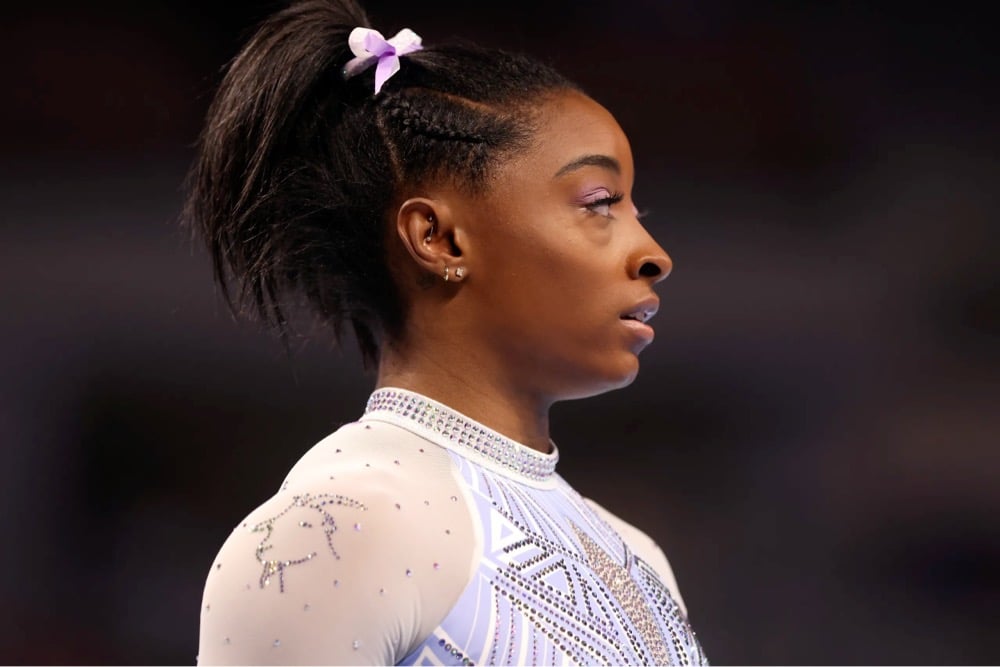
See also Who Could Jump Higher on a Trampoline, LeBron James or Simone Biles? (via the kid should see this)
Update: Physicist David Young analyzes Biles’ triple-double:
Assuming her rotation rates around each axis remain constant, to get three full flips in would require an extra 0.65 seconds, which requires a launch speed of 22.6 miles per hour, all other things being equal. This is not possible, even if we assume her max launch speed is 18 miles per hour, which is apparently her top sprinting speed.
However, if she could do three full flips, she would also be able to get in one-and-a-half more twists at her current rotation rate! What would this even be called?! What might be more likely would be to try to gain an extra half twist so that she would take off facing left and land facing right, still only completing two full flips.
(thx, donny)
Edo Period Shadow Puppetry Woodblock Prints



Circa 1842, ukiyo-e artist Utagawa Hiroshige released an 11-print series revealing the secrets of shadow puppetry performances. From the description of one of these woodblock prints held in the collection at The Minneapolis Institute of Art:
As comic entertainment, shadow performances were among the many diversions, including music and dance, offered at teahouse parties during the Edo period. In the eleven-print series Improvised Shadow Performances, Hiroshige depicted figures making shadows on shōji screens by contorting their bodies. The images demonstrate how to create ingenious shadows and could easily have been used as a how-to guide for clever shadow making.
You can find more of Hiroshige’s shadow prints at Ukiyo-e.org. (via colossal)
Adam Gopnik on the return of spending time together in public & private spaces after the worst of the pandemic. “What we call culture is basically the act of sharing air with strangers.”
Bo Burnham Welcomes You to the Internet
I have been hearing nothing but good things, and lots of them, about comedian Bo Burnham’s new show on Netflix called Inside. Burnham did the entire thing by himself in his house during the pandemic — writing, music, cinematography, editing, etc. In this clip from the show, Burnham performs a song called “Welcome to the Internet”. (via waxy)
Who Are You, Charlie Brown?
Who Are You, Charlie Brown? is a forthcoming feature-length documentary about the Peanuts comic strip and its creator, Charles Schulz.
Honoring the “everyman” creator, Charles “Sparky” Schulz, “Who Are You, Charlie Brown?” celebrates the significance and global multi-generational popularity of the comic strip and its timeless artistry and design to profile the man whose simple characters would touch the lives of millions through the decades and become beloved cultural icons. Featuring interviews with Jean Schulz, the widow of Charles Schulz, along with Drew Barrymore, Al Roker, Kevin Smith, Billie Jean King, Paul Feig, Ira Glass, Noah Schnapp, Miya Cech, Keith L. Williams, Chip Kidd, Lynn Johnston, Robb Armstrong and more, the documentary interweaves a new animated story that follows Charlie Brown on a quest to discover himself.
Narrated by Lupita Nyong’o, the film premieres on Apple TV+ on June 25.
England fans are booing players taking the knee in solidarity against racism in soccer. This was the most disheartening part about fans returning to stadiums in the Premier League – hearing boos as players knelt.
Germany Came to Terms with Its Nazi Past. Why Can’t America Do the Same with Slavery?
For the Washington Post, Michele Norris wonders what it will take for the US to finally and fully acknowledge its history of slavery.
America experienced 246 years of slavery before it was officially ended with the passage of the 13th Amendment. That was followed by decades of legal segregation and oppression under Jim Crow, followed by a period of willful blindness and denial. A tourist from a foreign land might well conclude that the Confederacy had actually won the Civil War, based on the number of monuments, buildings and boulevards still named for heroes of its defeated army. The real truth of our shared history was a casualty of that war and, like any wound left untended, the results can be catastrophic.
A full accounting of slavery is one of terror and trauma, and for decades the natural inclination was to ask, why would anyone want to claim that history? But at a moment when the United States is dangerously divided, when we are having bitter and overdue conversations about policing, inequality and voting rights, when marauders fueled by white-nationalist rhetoric can overwhelm the Capitol, proudly waving the Confederate battle flag, the more important question is this: What happens if we don’t?
She uses Germany’s remembrance and examination of Nazism and the Holocaust as an example of a country that has properly faced up to its terrible past in order to move fully forward.
Vergangenheitsaufarbeitung refers to Germany’s efforts to interrogate the horrors of the Holocaust and the rise of Nazism. It has been a decades-long exercise, beginning in the 1960s, to examine, analyze and ultimately learn to live with an evil chapter through monuments, teachings, art, architecture, protocols and public policy. The country looks at its Nazi past by consistently, almost obsessively, memorializing the victims of that murderous era, so much so that it is now a central feature of the nation’s cultural landscape. The ethos of this campaign is “never forget.”
I visited Germany back in 2018 and its efforts to engage with past horrors were quite noticeable and stood in stark contrast to American activity along similar lines.
In particular, as a nation the US has never properly come to terms with the horrors it inflicted on African Americans and Native Americans. We build monuments to Confederate soldiers but very few to the millions enslaved and murdered. Our country committed genocide against native peoples, herded them onto reservations like cattle, and we’re still denying them the right to vote.
As Norris convincingly argues, “it is long past time to face where truth can take us”.
There’s going to be an annular solar eclipse on June 10 that will be partially visible in the US, particularly on the East Coast. “From New York City, the eclipse magnitude will reach a whopping 0.80 (80%).”
N.K. Jemisin’s The Broken Earth trilogy will be adapted into something (movie series? TV series?) by TriStar & Jemisin herself.
Great profile of Mare of Easttown’s Kate Winslet. “But she is not Daniel Day-Winslet; she is said to be fun once the shooting wraps for the day.”
The Mistake Waltz
This is a 3-minute clip of The Concert (or The Perils of Everybody) by choreographer Jerome Robbins, in which the dancers are intentionally, and comically, out of sync. You can see why it’s colloquially called the Mistake Waltz. Open Culture’s Ayun Halliday has collected several more of these performances in this post.
It must be incredibly hard for dancers to execute this piece, to deliberately perform out of step with the music and their fellow performers after a lifetime of practice & performance designed to drill the opposite instinct to them. Bravo!
YES! A prequel to Master and Commander: The Far Side of the World is in the works. Rewatched M&C during the pandemic and it’s a masterpiece.
Roadrunner: A Film About Anthony Bourdain
Filmmaker Morgan Neville (who did the Fred Rogers doc Won’t You Be My Neighbor?) has directed a documentary about Anthony Bourdain called Roadrunner that opens in theaters on July 16.
It’s not where you go. It’s what you leave behind… Chef, writer, adventurer, provocateur: Anthony Bourdain lived his life unabashedly. Roadrunner: A Film About Anthony Bourdain is an intimate, behind-the-scenes look at how an anonymous chef became a world-renowned cultural icon. From Academy Award®-winning filmmaker Morgan Neville (20 Feet From Stardom, Won’t You Be My Neighbor?), this unflinching look at Bourdain reverberates with his presence, in his own voice and in the way he indelibly impacted the world around him.
This trailer makes me want to buy a movie ticket — and about 10 plane tickets. So looking forward to this. I need more unabashed living in my life.
The National Farmers Union: Farmers Deserve the Right to Repair Their Tractors. “95% of large farm tractors are made by just three companies…which engage in the kind of resource restriction that prevents on-farm repairs.”
The Last Free Election in America
Yale historian Timothy Snyder has been one of the most prominent & insistent voices warning against the rise of authoritarianism & fascism in the United States in recent years — you may remember his 20 lessons from the 20th century on fighting authoritarianism from November 2016 and his more recent piece on the right’s coup attempt on January 6th.
Over the weekend, Snyder published a short piece about what he believes will happen as a result of the 1/6 insurrection and the Republicans’ ongoing effort to push their Big Lie about election fraud — basically the end of democracy in America.
I have the Cassandra feeling this spring because it is so obvious where all of this is heading. President Trump tells a big lie that elections are rigged. This authorizes him and others to seek power in extra-democratic ways. The lie is institutionalized by state legislation that suppresses voting, and that gives state legislatures themselves the right to decide how to allocate the electoral vote in presidential elections.
The scenario then goes like this. The Republicans win back the House and Senate in 2022, in part thanks to voter suppression. The Republican candidate in 2024 loses the popular vote by several million and the electoral vote by the margin of a few states. State legislatures, claiming fraud, alter the electoral count vote. The House and Senate accept that altered count. The losing candidate becomes the president. We no longer have “democratically elected government.” And people are angry.
No one is seeking to hide that this is the plan. It is right there out in the open. The prospective Republican candidates for 2024, Donald Trump, Ted Cruz, and Josh Hawley, are all running on a big lie platform. If your platform is that elections do not work, you are saying that you intend to come to power some other way. The big lie is designed not to win an election, but to discredit one. Any candidate who tells it is alienating most Americans, and preparing a minority for a scenario where fraud is claimed. This is just what Trump tried in 2020, and it led to a coup attempt in January 2021. It will be worse in January 2025.
Like he says, so obvious and out in the open. As far as I’m concerned, this is a done deal and there’s not a lot that can be done to stop it. The horse left the barn some time ago and most people can’t even tell the door is open, much less that it needs closing.
Jeff Bezos is going to space. I mean, what’s the sense in being the billionaire owner of a spaceship company if you’re not going to launch yourself into space?
Velox, the Amphibious Robot
A Brooklyn company called Pliant Energy Systems has developed a prototype of an amphibious robot that can swim, skate, slither, and crawl through water and over all different kinds of terrain. The secret is an undulating propulsion system that can modified on the fly to adapt to different conditions.
Velox can use several modes of locomotion found in the animal kingdom using just one pair of “fins”. These fins are best described as four-dimensional objects with a hyperbolic geometry that allows the robot to swim like a ray, crawl like a millipede, jet like a squid, and slide like a snake.
A craft equipped with this system has unprecedented freedom to travel through a range of environments in a single mission. As an underwater vehicle, the robot’s ability to instantly reverse direction and do quick turns make it ideal for task such as coral reef inspection or dragon fish hunting where a craft must rapidly maneuver to look around and between objects.
(thx, dunstan)
QAmom
Sean Donnelly’s mother got sucked into the world of QAnon conspiracy theories, so he made a little video about it, including documenting some bets he made with her about whether or not Biden would still be in office 3 months after the inauguration or if Tom Hanks & Oprah would soon be arrested for pedophilia. Remember when Baby Boomers were all concerned that the internet was going to be harmful for their Gen X and Millennial children and grandchildren? And now all these Boomers are getting brainwashed by Facebook and Fox News? Good stuff. :|
See also QAnon, Conspiracy Theories, and the Rise of Magical Thinking, What Can You Do About QAnon?, Sacha Baron Cohen Says Tech Companies Built the “Greatest Propaganda Machine in History”, Living in a Conspiracy Nation, In Search of a Flat Earth, and My Dad, the Facebook Addict. (via waxy)
The 2021 Milky Way Photographer of the Year
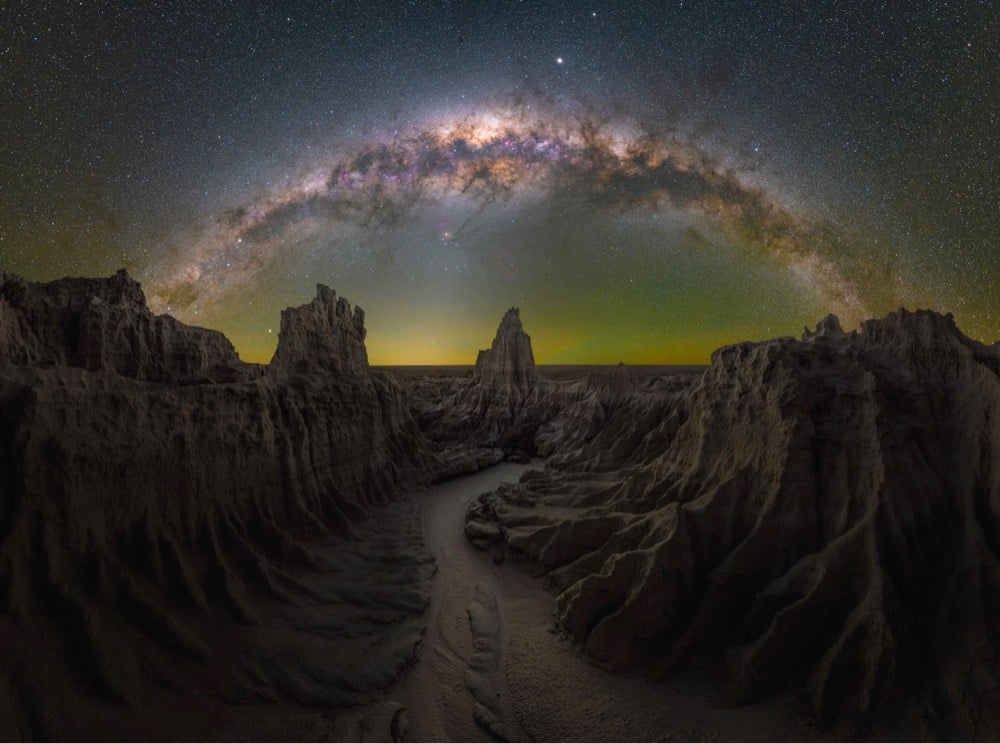
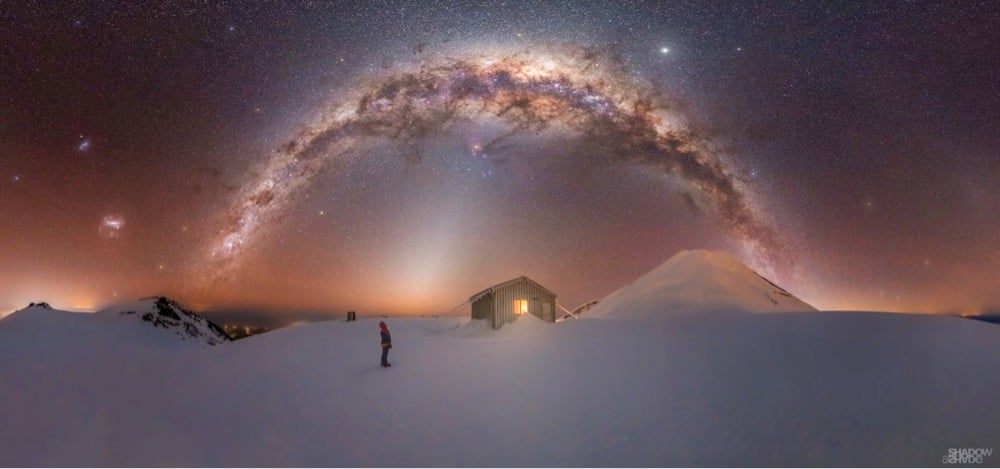
To inspire folks to seek out their own galactic vistas, Capture the Atlas has chosen the best photos of the Milky Way for 2021. The top photo was taken by Daniel Thomas Gum in Australia and the bottom one by Larryn Rae in New Zealand. Check out the rest of the selections here.
Footsteps: How Movie Sounds Are Made
As I’ve said before many times, I will never stop being fascinated by the work of Foley artists, the folks who make the sounds you hear in movies and TV shows. In this short film, we meet three Foley artists who work at Footsteps Studios, a custom designed facility in rural Ontario that includes a massive warehouse of props that can make any sound you can dream of. This video is full of lovely little moments and details — recommended.
Pediatrician Perri Klass: vaccinate your children. “Children now account for more than 22 percent of all new COVID-19 cases, and even those children who aren’t very sick may have to deal with possible long-term complications.”
The Typography of Watches



From Our Favourite Uses of Typography in Watches:
Good typography should be almost unnoticeable. Blending seamlessly into the rest of the design, it should tell you everything you need to know, without you being aware of it. Despite the many restrictions that are applied to dial layout, the creativity that can be seen in typography across horology is quite staggering. To put it simply, typography is the art and technique of arranging type to make written language legible and appealing when displayed. As the dial is the main point of interaction with a watch, it is arguably one of its most important parts, and certainly one that can produce the most emotion. This is why typeface can play such a vital, yet subtle, role in how we experience and feel about a certain piece.
(via the fox is black)
Jumping from 25,000 Feet Without a Parachute and Landing Safely
WHAAAAAAATTT the hell did I just watch? In 2016, Luke Aikins became the first person to intentionally jump and land without the aid of a parachute or wingsuit — check out the video above to see how he does it. At one point, his heart rate is displayed on the screen and I’m certain that mine was in the same ballpark just before he landed. I recommend you also watch a video of the jump narrated by Aikins as he talks through what’s happening before, during, and after the jump.
See also Gary Connery’s 2012 jump — he fell 2400 feet from a helicopter and landed on a huge pile of cardboard boxes with the aid of a wingsuit, which slowed his vertical velocity to about 15 mph.
FYI: The jump height of 25,000 feet seems impressive (and it’s probably trickier hitting the target from higher up) but in terms of speed, about 1500 feet is sufficient for a freefalling human in the spread-eagle position to reach their maximum (terminal) velocity of ~120 mph. Anything over 1500 feet, about half the height of El Capitan’s granite face, doesn’t add any additional speed. (via @mikeindustries)
Flat-Packed Pastas That Pop Open When Cooked
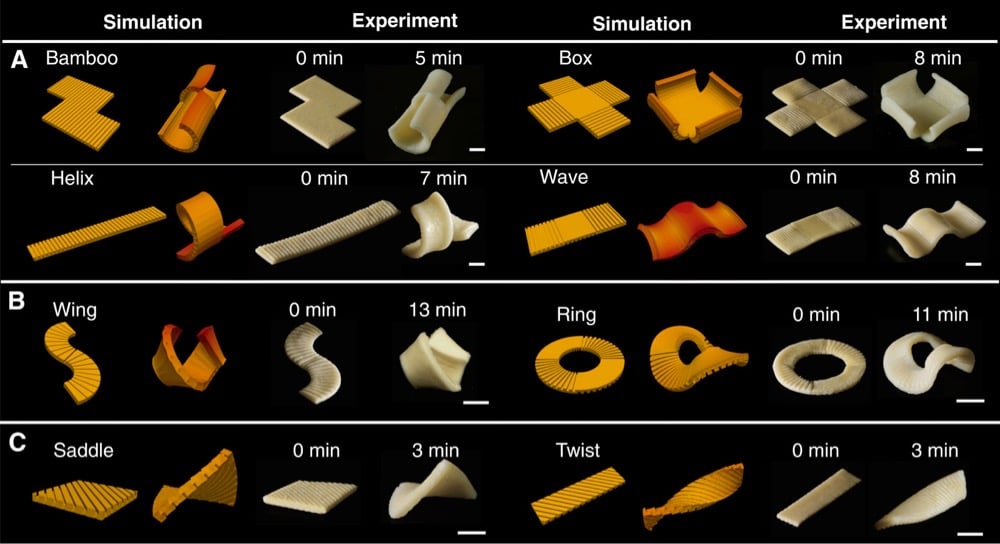
Inspired by space-saving flat-packed furniture, scientists at Carnegie Mellon University have developed a technique for making pasta shapes that start out flat when dry but “morph” into their final 3D shapes when cooked. The secret is stamping different groove patterns into the pasta dough.
The solution: something Wang, Yao, and their co-authors term “groove-based transient morphing.” They found that stamping flat pasta sheets with different groove patterns enabled them to control the final pasta shape after cooking. According to the authors, the grooves increase how long it takes to cook that part of the pasta. So those areas expand less than the smooth areas, giving rise to many different shapes.
The team found that the pasta reached its maximum bending angle after about 12 minutes and retained this angle for around 20 minutes before it began to bend back. The researchers were able to produce simple helical and cone shapes, as well as more complex saddles and twists (the latter achieved by introducing double-sided grooves).
I am assuming those grooves would also aid in holding sauce better, a topic we’ve delved into recently. You can read the full research paper on the morphing pasta here. (via the prepared)
The Bob Ross Virtual Art Gallery. All 403 paintings done by Ross on the Art of Painting, including an analysis and visualization of the colors he used for each one.
The Winners of the BigPicture Natural World Photography Competition for 2021
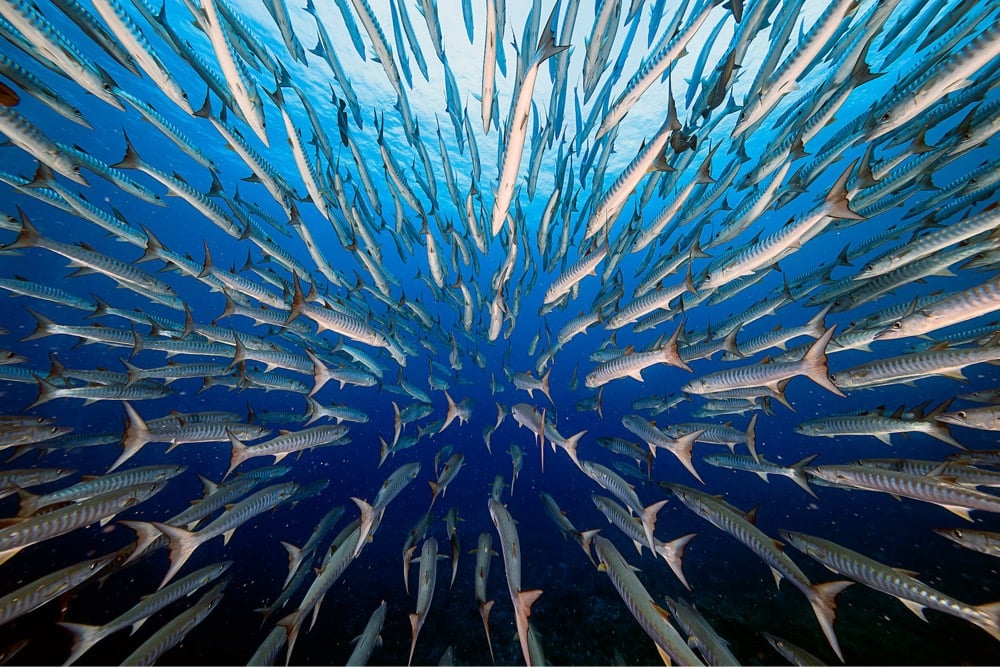
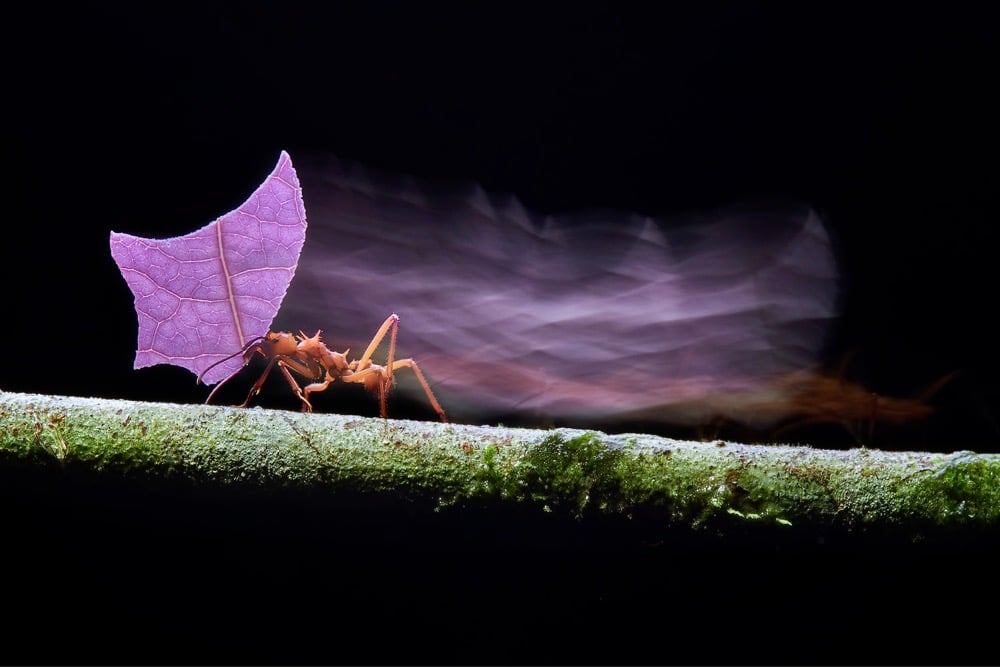

The California Academy of Sciences has announced the winners (and finalists) of their BigPicture Natural World Photography Competition for 2021. I’ve included a few favorites above: barracuda by Yung-Sen Wu, leafcutter ants by Petr Bambousek, and lynx spiders by Lung-Tsai Wang. See all of the winners and finalists here. (via in focus)
A Brief History of Netflix Personalization. “In twenty years, Netflix has gone from members choosing 2% of the movies the merchandising system suggests to 80% today.”
Juggling from Above
Juggling, from the usual angle, looks like a very hectic endeavor — balls and clubs and hands flying everywhere. But if you get an overhead view, as in this video from Taylor Glenn, you can see that often there’s very little movement in two of the three dimensions. The mastery of these small movements combined with the sweeping up-and-down motions creates a compelling illusion for ground-based viewers. The power of a different perspective. (via the kid should see this)
Four Laps: a Looping Video About Looping Videos
For a talk at the Ignite conference, Marcin Wichary created a looping video about looping videos — you know, when the action in a video loops back over previous scenes, adding new layers of interaction as time goes on. (Think Marty McFly revisiting scenes from Back to the Future in Back to the Future 2.) Most impressively: he did it all live — and here’s a behind-the-scenes look at how.
America’s Drinking Problem
This piece on alcohol and the human fixation on it is interesting throughout — and/because it includes the sentence: “For an illustration of what followed, I direct you to the film Dazed and Confused.”
But even presuming that this story of natural selection is right, it doesn’t explain why, 10 million years later, I like wine so much. “It should puzzle us more than it does,” Edward Slingerland writes in his wide-ranging and provocative new book, Drunk: How We Sipped, Danced, and Stumbled Our Way to Civilization, “that one of the greatest foci of human ingenuity and concentrated effort over the past millennia has been the problem of how to get drunk.” The damage done by alcohol is profound: impaired cognition and motor skills, belligerence, injury, and vulnerability to all sorts of predation in the short run; damaged livers and brains, dysfunction, addiction, and early death as years of heavy drinking pile up. As the importance of alcohol as a caloric stopgap diminished, why didn’t evolution eventually lead us away from drinking-say, by favoring genotypes associated with hating alcohol’s taste? That it didn’t suggests that alcohol’s harms were, over the long haul, outweighed by some serious advantages.
Versions of this idea have recently bubbled up at academic conferences and in scholarly journals and anthologies (largely to the credit of the British anthropologist Robin Dunbar). Drunk helpfully synthesizes the literature, then underlines its most radical implication: Humans aren’t merely built to get buzzed-getting buzzed helped humans build civilization. Slingerland is not unmindful of alcohol’s dark side, and his exploration of when and why its harms outweigh its benefits will unsettle some American drinkers. Still, he describes the book as “a holistic defense of alcohol.” And he announces, early on, that “it might actually be good for us to tie one on now and then.”
But hard liquor and solitary drinking changed the game.
Southern Europe’s healthy drinking culture is hardly news, but its attributes are striking enough to bear revisiting: Despite widespread consumption of alcohol, Italy has some of the lowest rates of alcoholism in the world. Its residents drink mostly wine and beer, and almost exclusively over meals with other people. When liquor is consumed, it’s usually in small quantities, either right before or after a meal. Alcohol is seen as a food, not a drug. Drinking to get drunk is discouraged, as is drinking alone. The way Italians drink today may not be quite the way premodern people drank, but it likewise accentuates alcohol’s benefits and helps limit its harms. It is also, Slingerland told me, about as far as you can get from the way many people drink in the United States.
UFOs Are Not Aliens
Due to recent government reports, declassified data, media interest in those data & reports, and a long-simmering interest by the public, UFOs are back in the public imagination. Adam Frank, an astrophysicist at the University of Rochester who is searching for signs of extraterrestrial life, says that there’s little chance that UFOs are aliens.
I understand that U.F.O. sightings, which date back at least to 1947, are synonymous in the popular imagination with evidence of extraterrestrials. But scientifically speaking, there is little to warrant that connection. There are excellent reasons to search for extraterrestrial life, but there are equally excellent reasons not to conclude that we have found evidence of it with U.F.O. sightings.
If UFOs are alien craft, we would never see them:
There are also common-sense objections. If we are being frequently visited by aliens, why don’t they just land on the White House lawn and announce themselves? There is a recurring narrative, perhaps best exemplified by the TV show “The X-Files,” that these creatures have some mysterious reason to remain hidden from us. But if the mission of these aliens calls for stealth, they seem surprisingly incompetent. You would think that creatures technologically capable of traversing the mind-boggling distances between the stars would also know how to turn off their high beams at night and to elude our primitive infrared cameras.
More people talking about a thing doesn’t make it credible. More people talking about potential evidence of a thing doesn’t make it credible. Evidence makes something credible.
Why Are So Many of My Fellow Health Workers Unvaccinated? Even though eligible since December, “as of early March 2021, surveys showed that nearly half of frontline health care workers remained unvaccinated”.




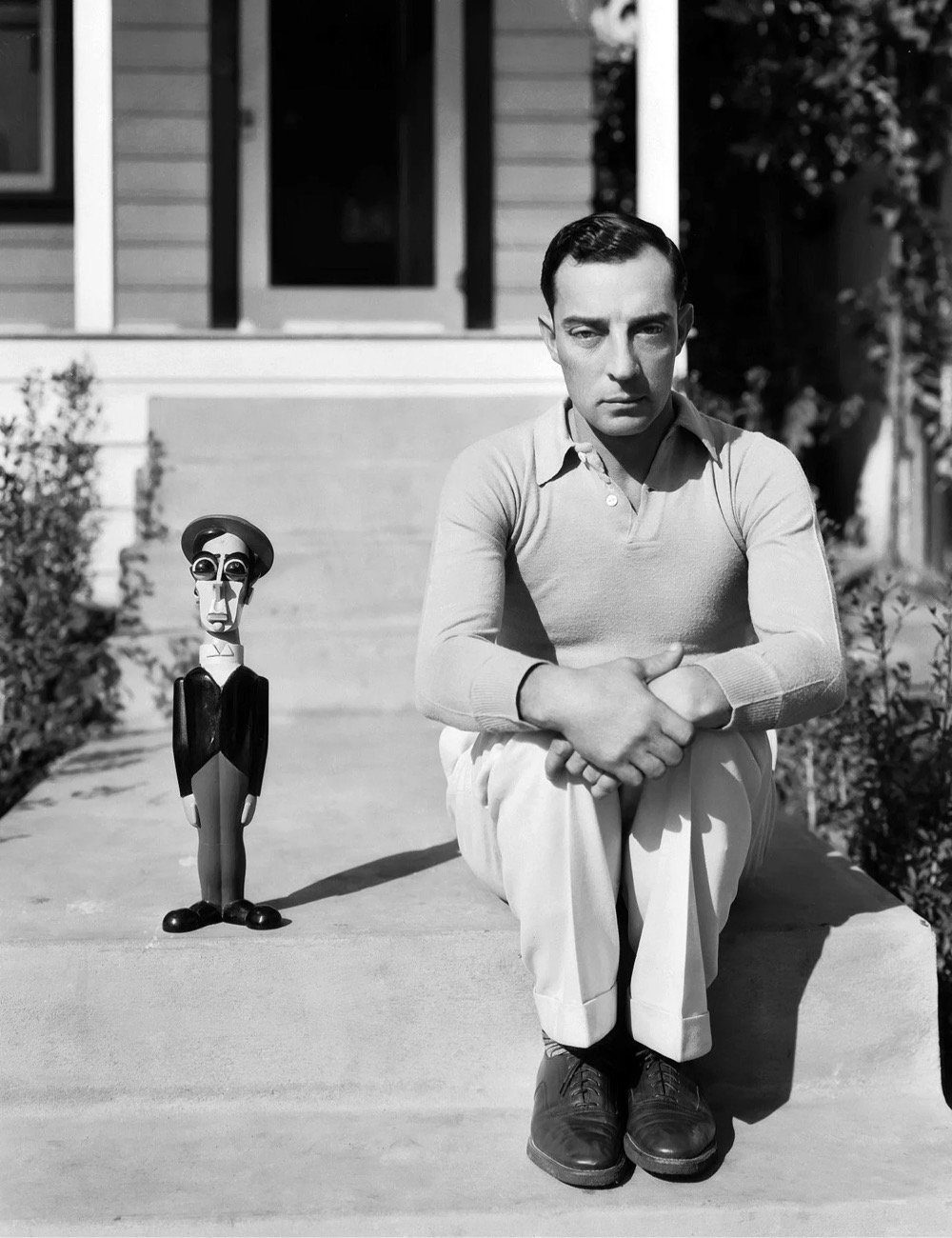
Stay Connected